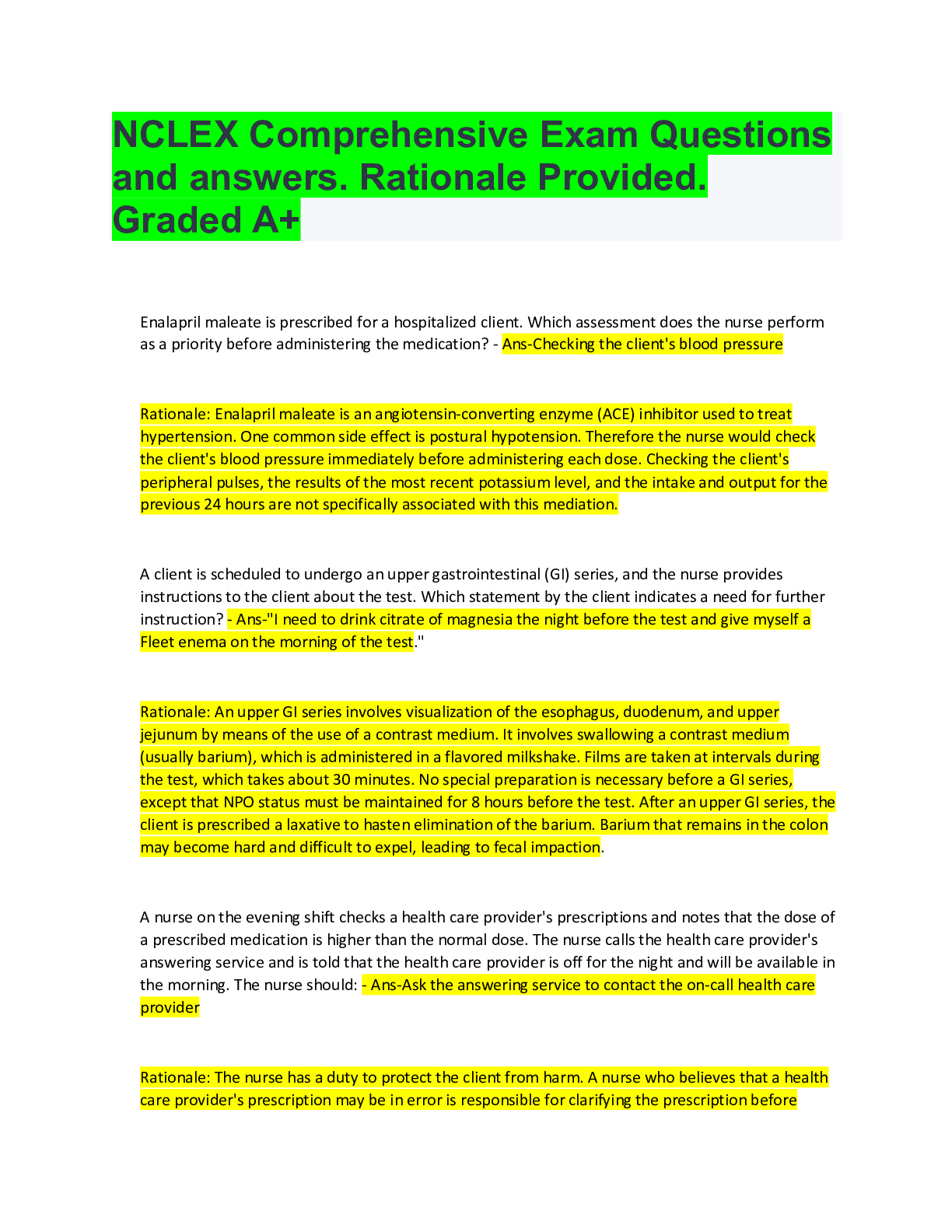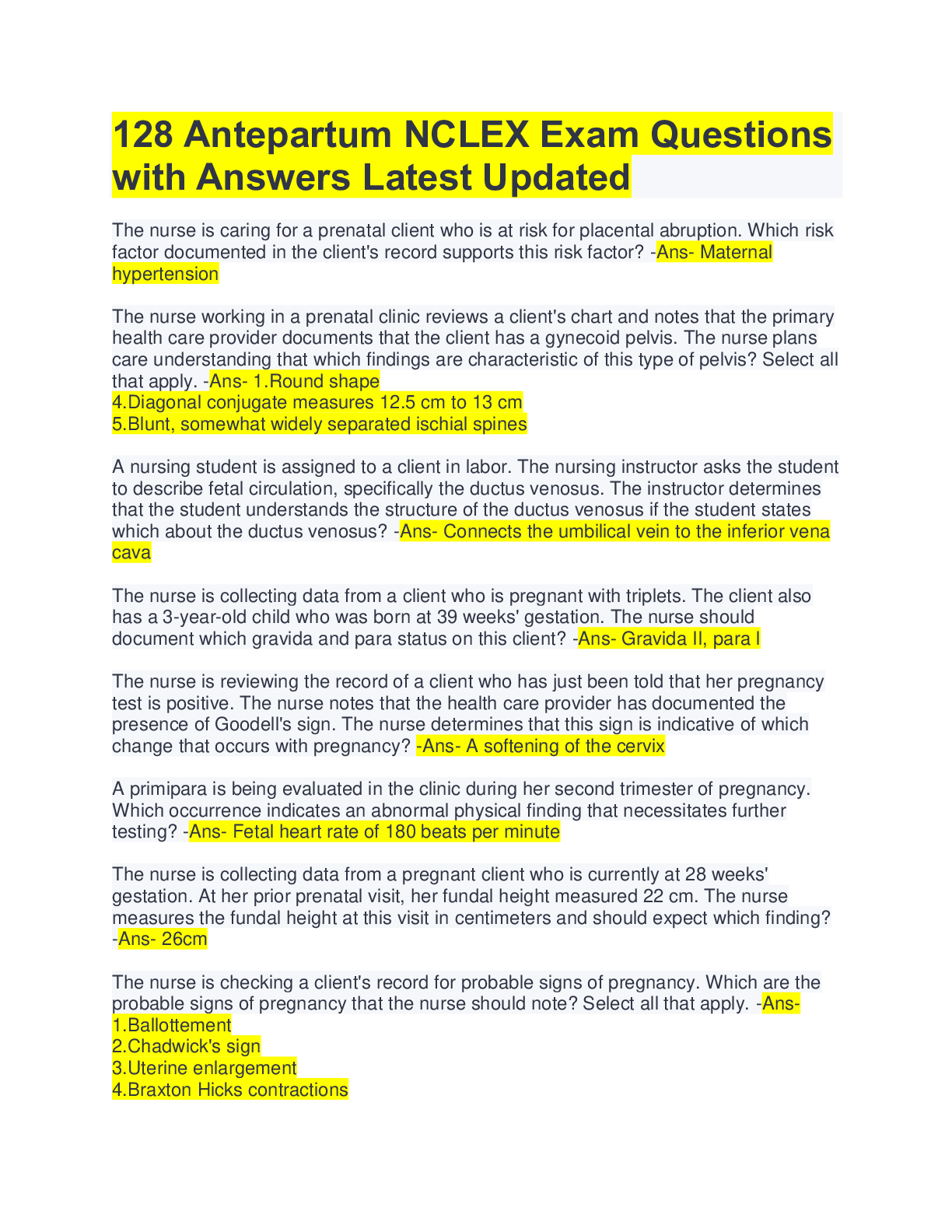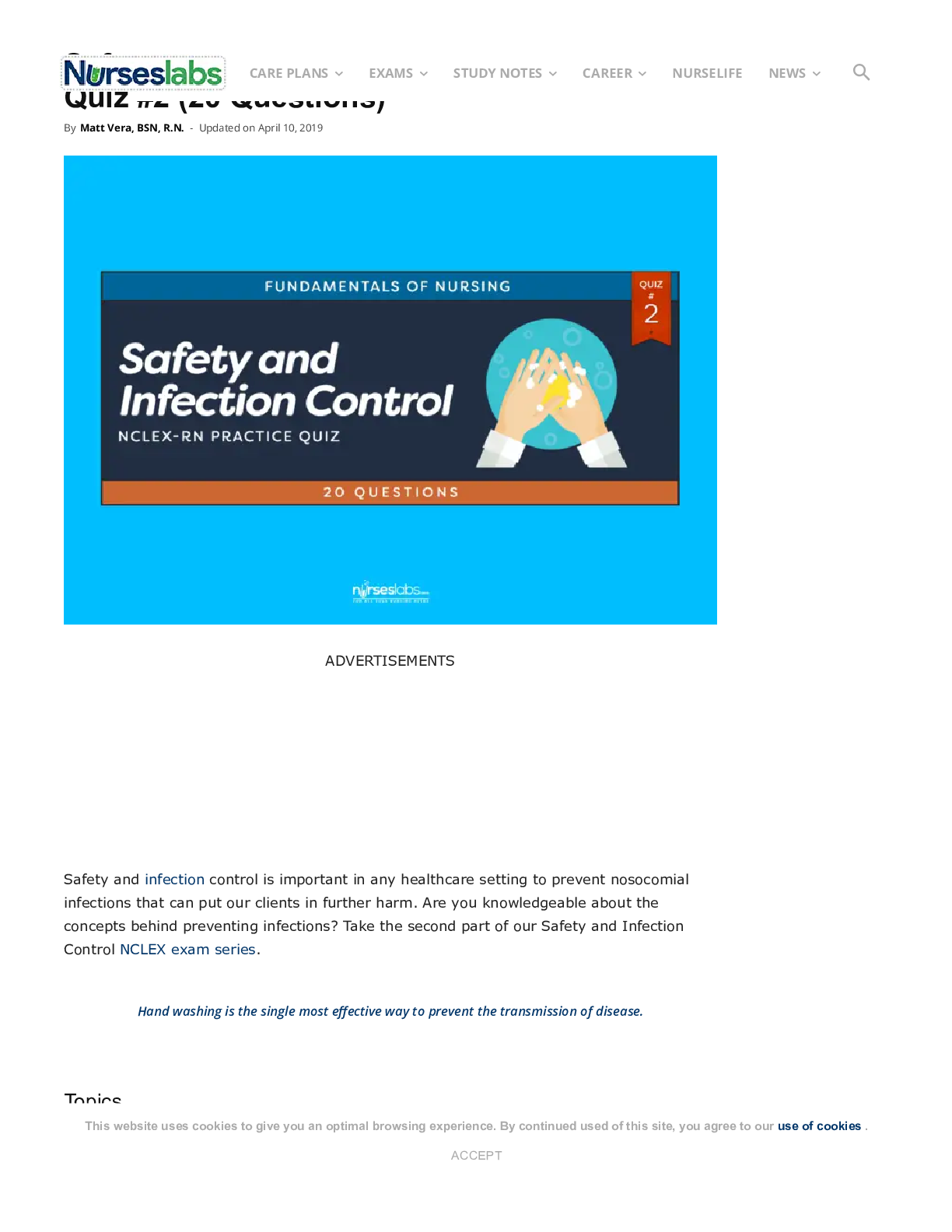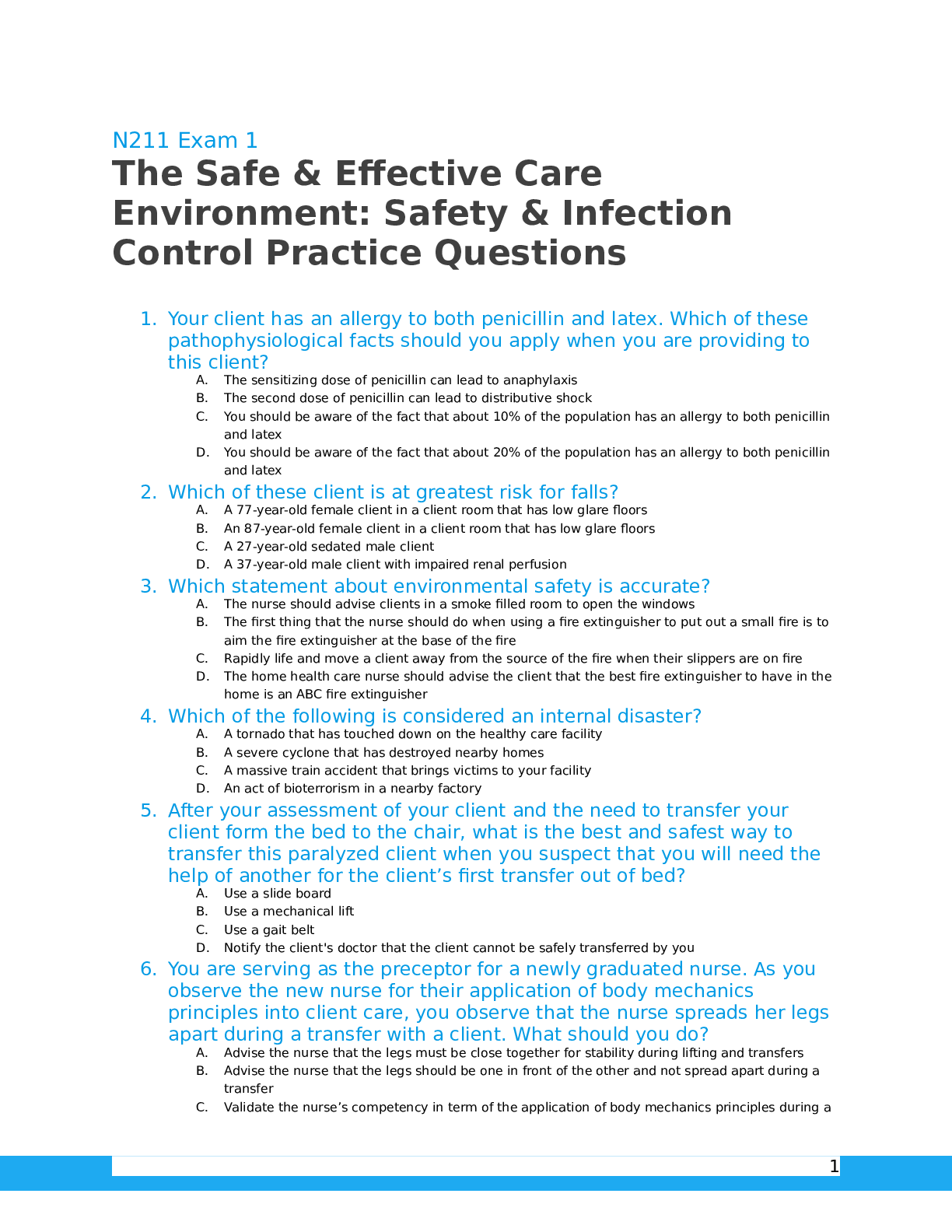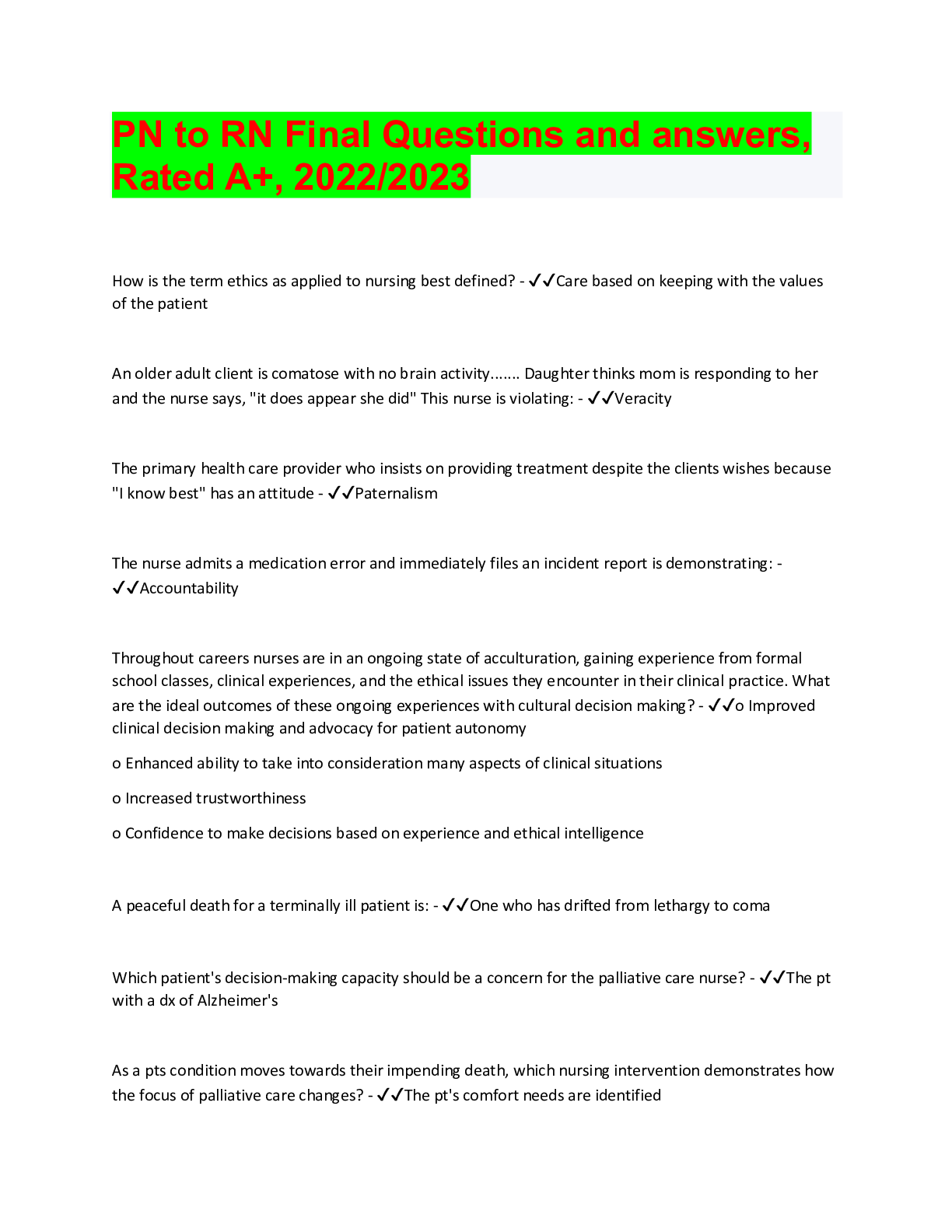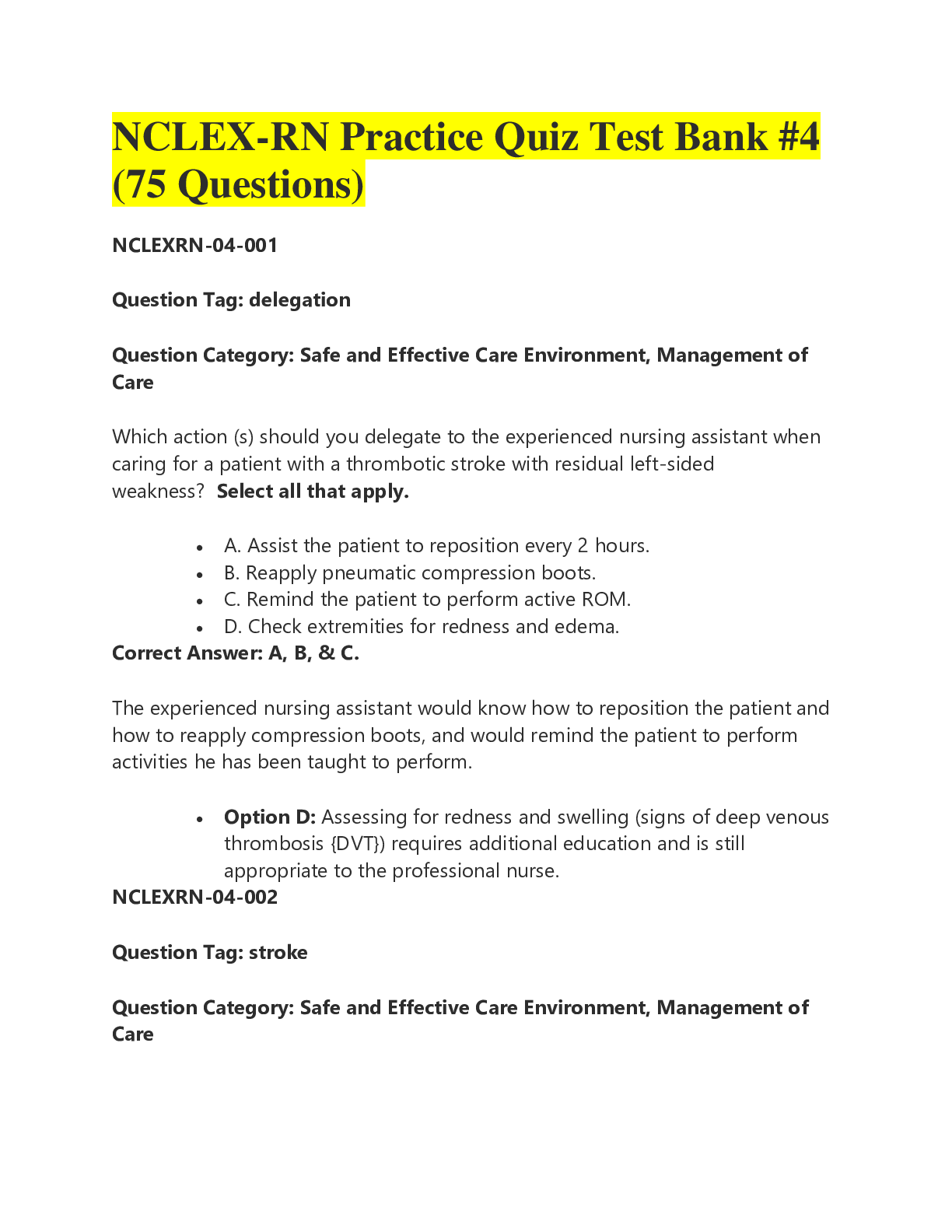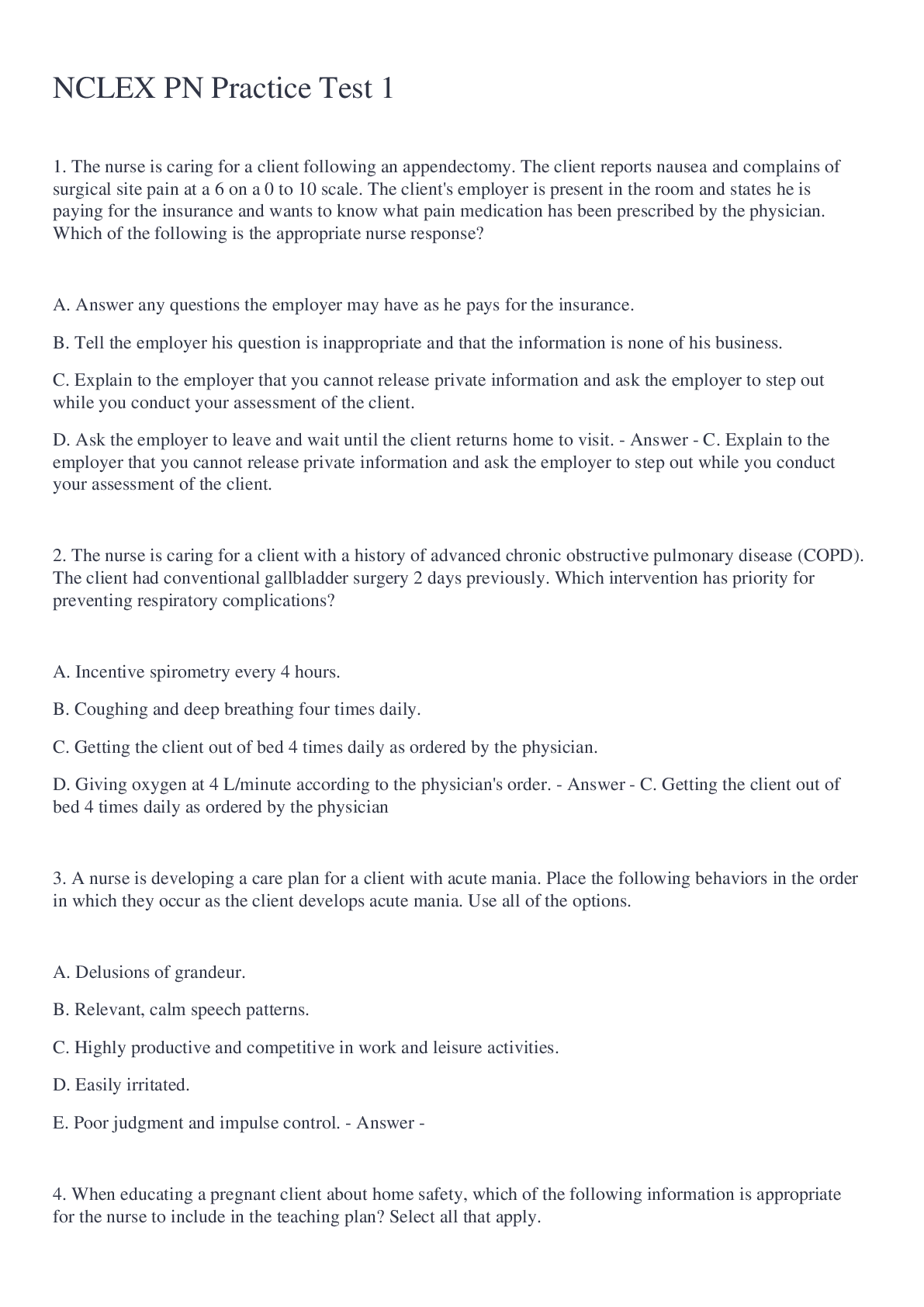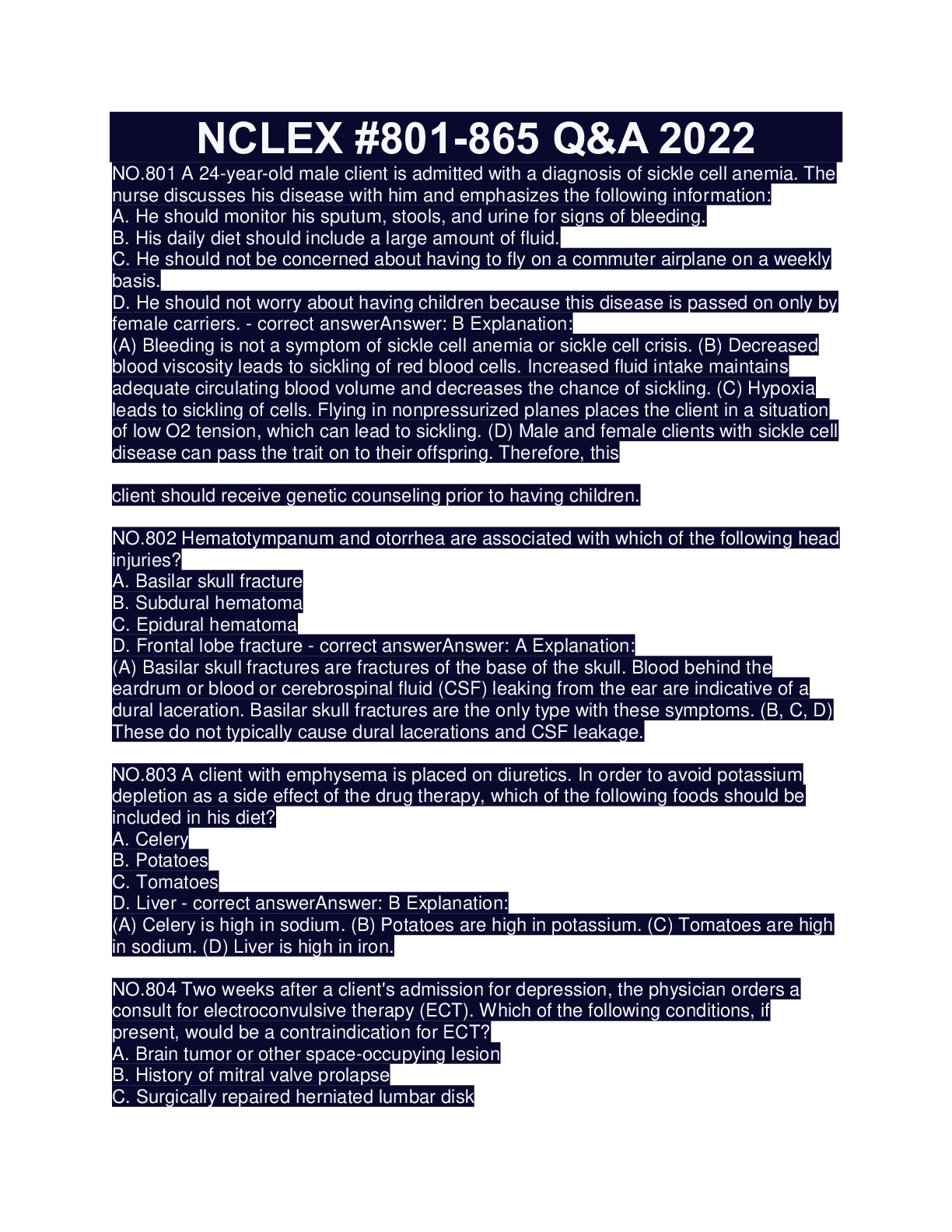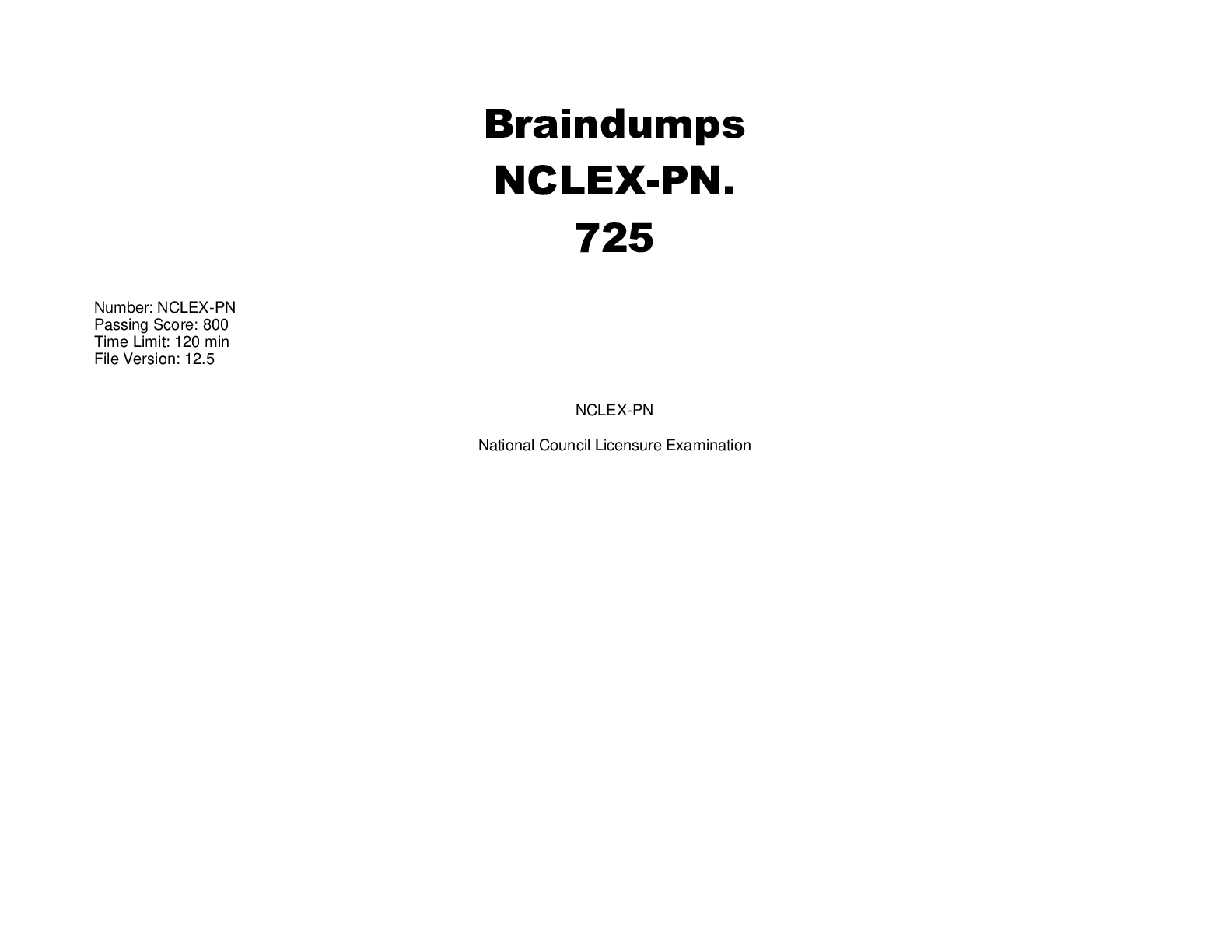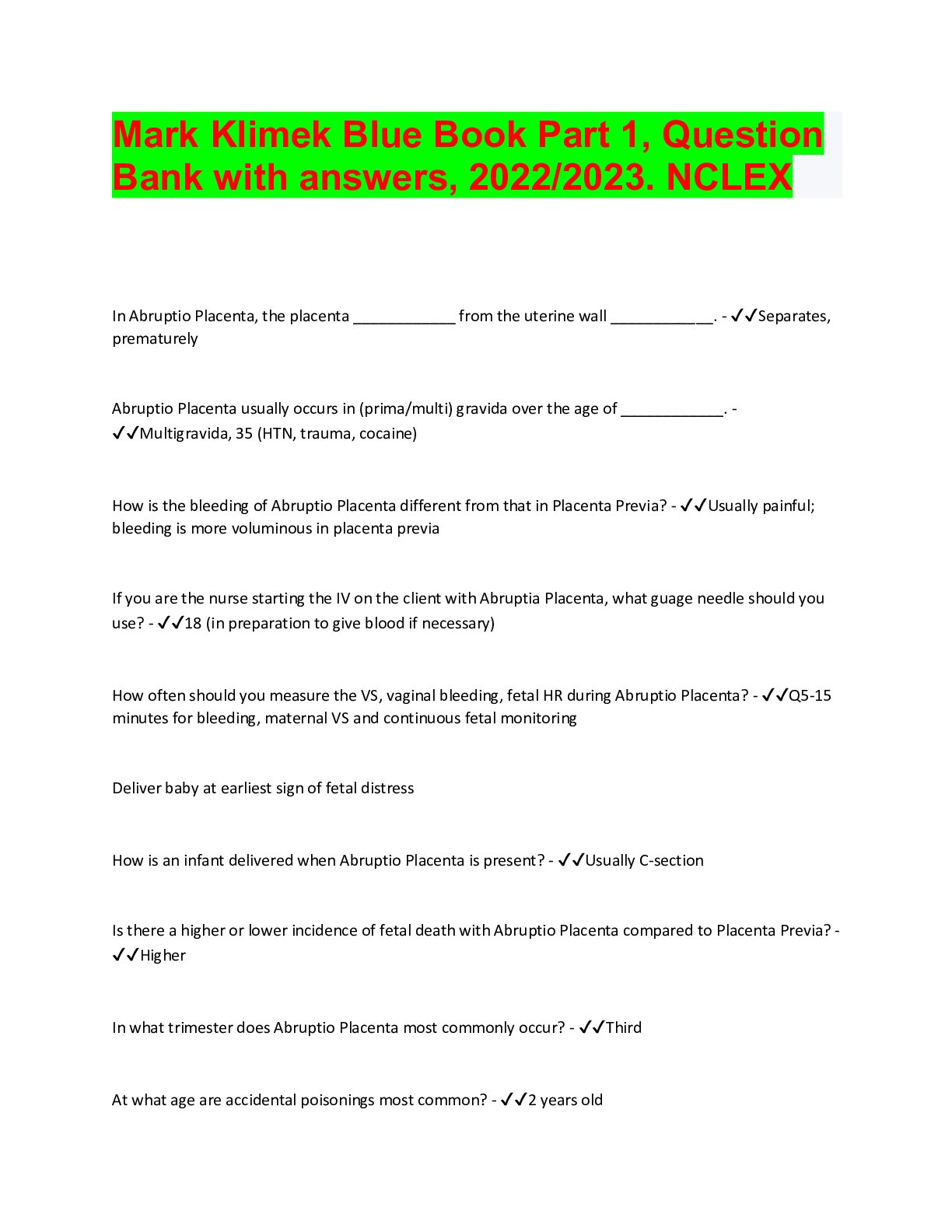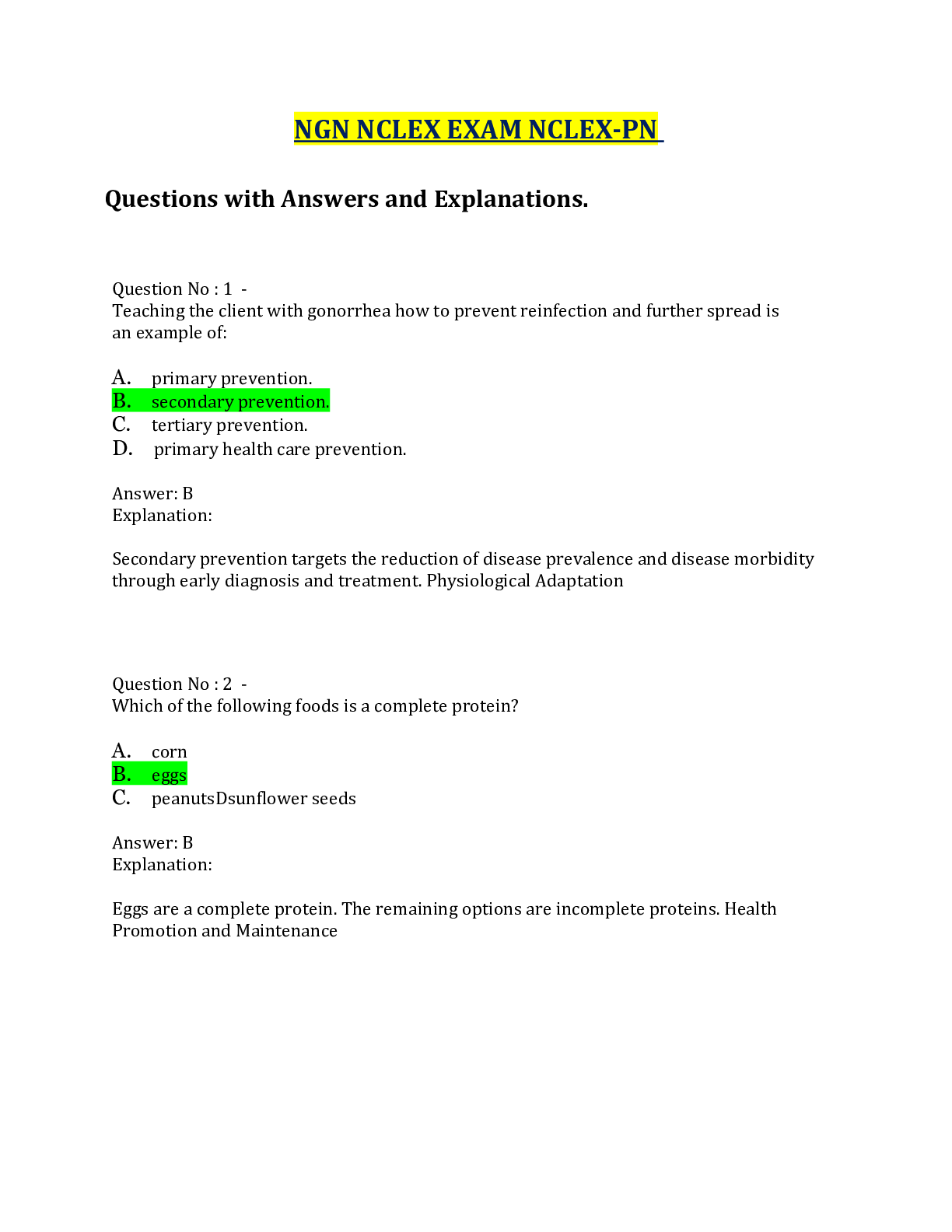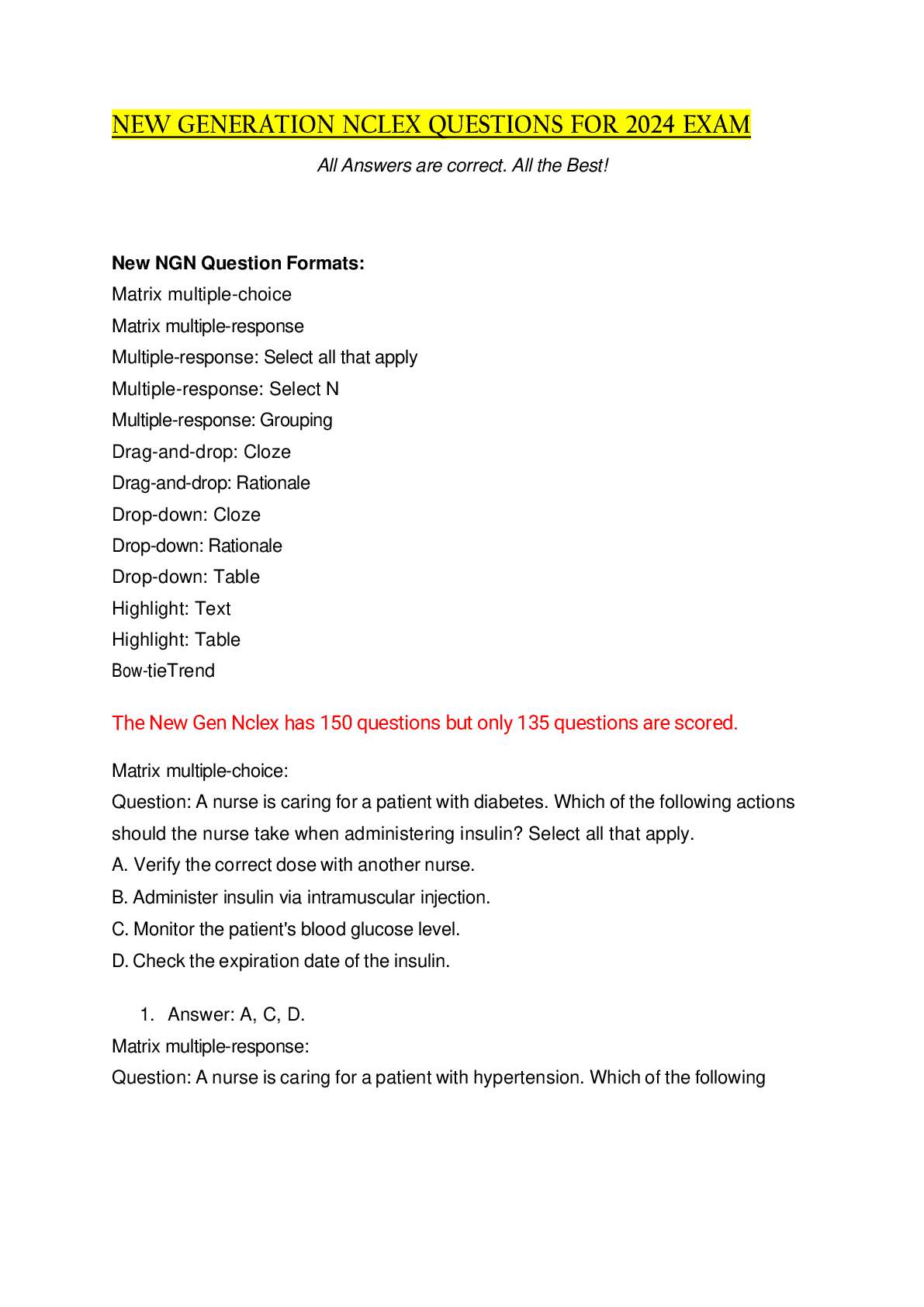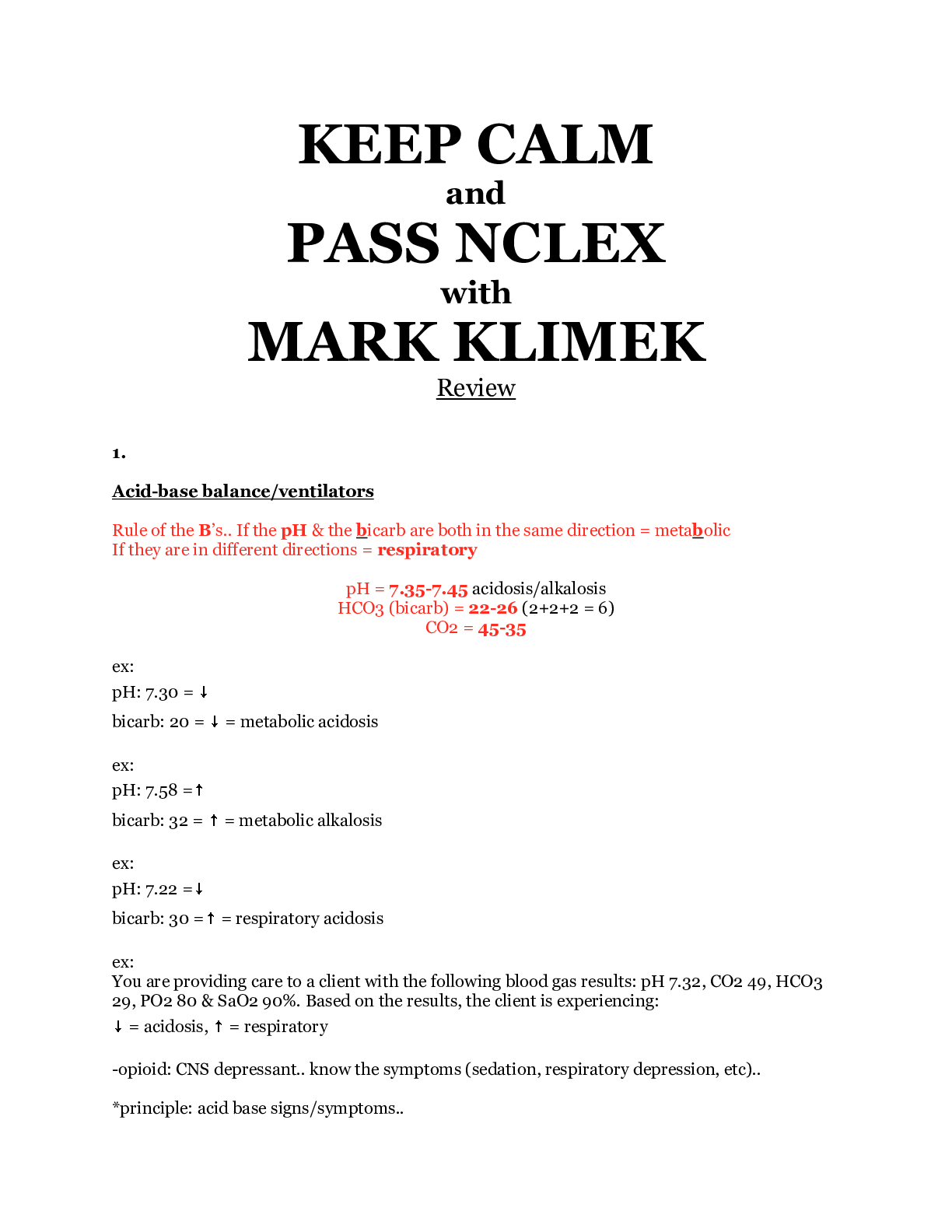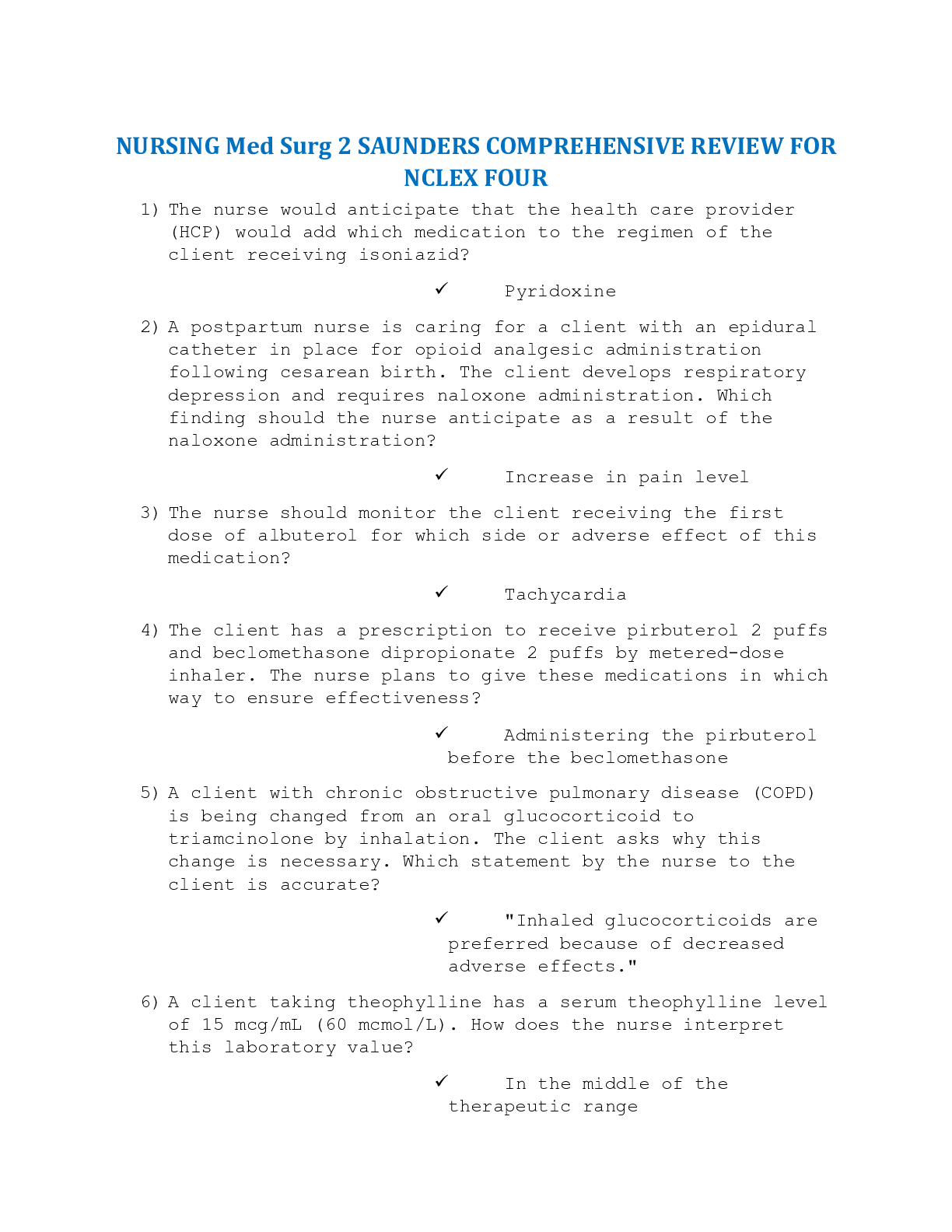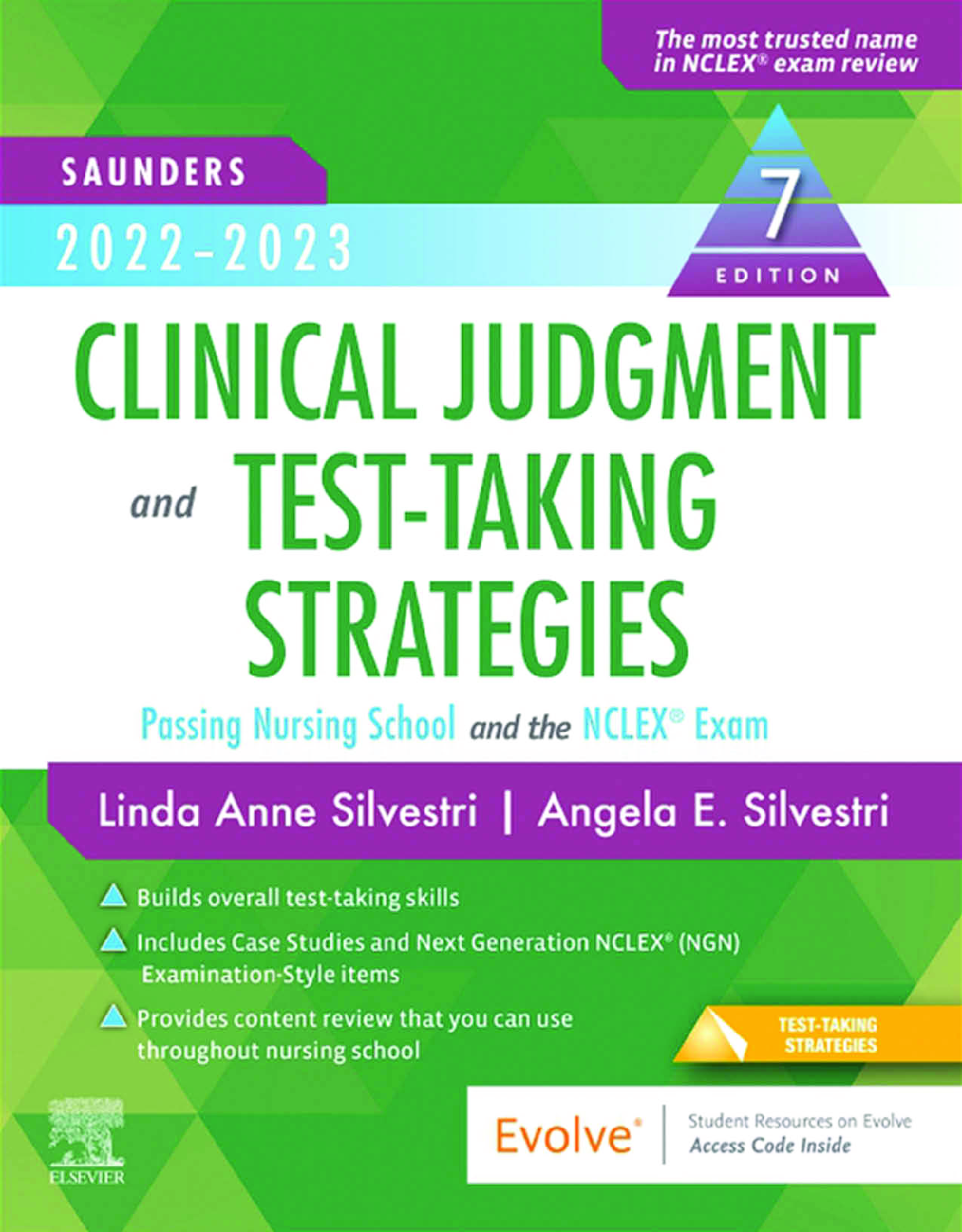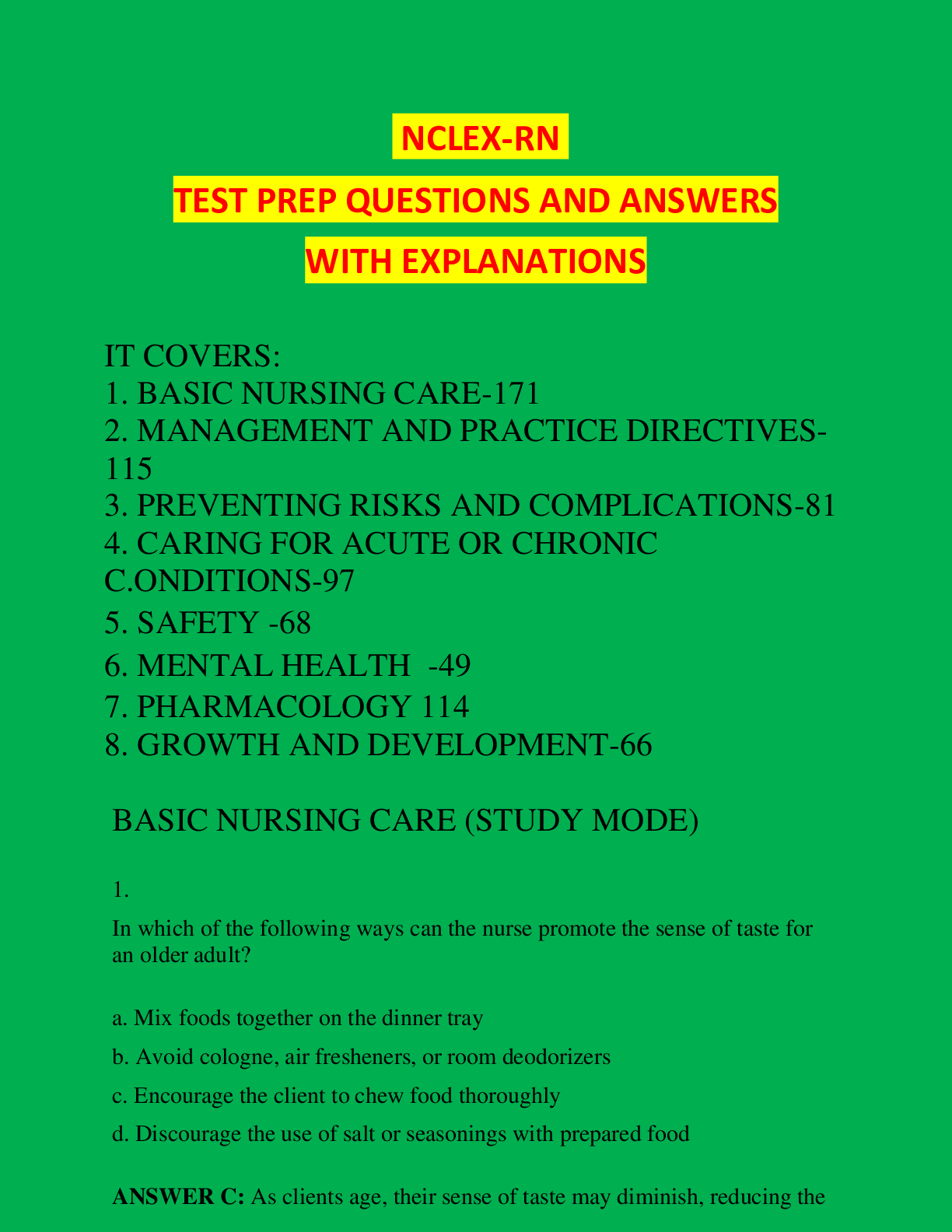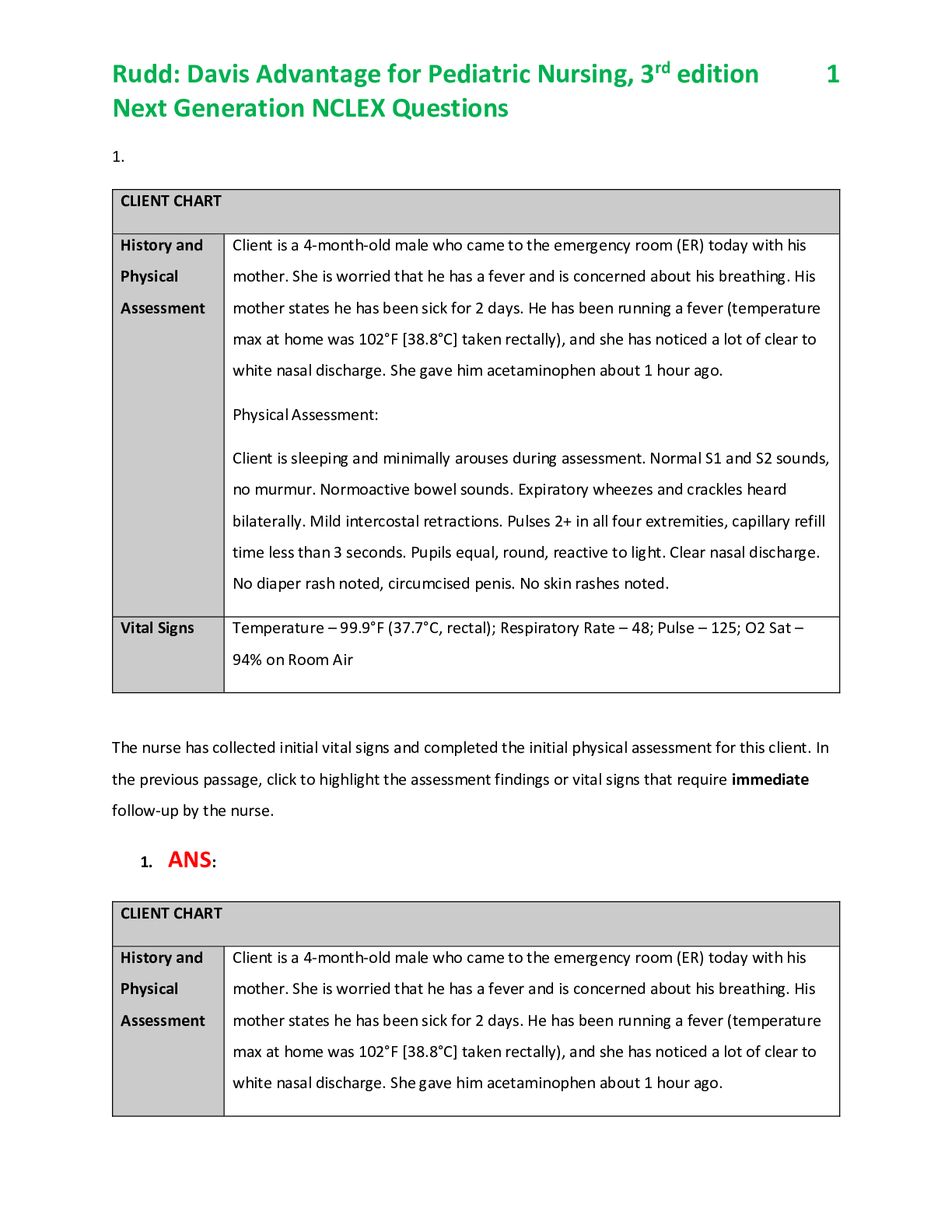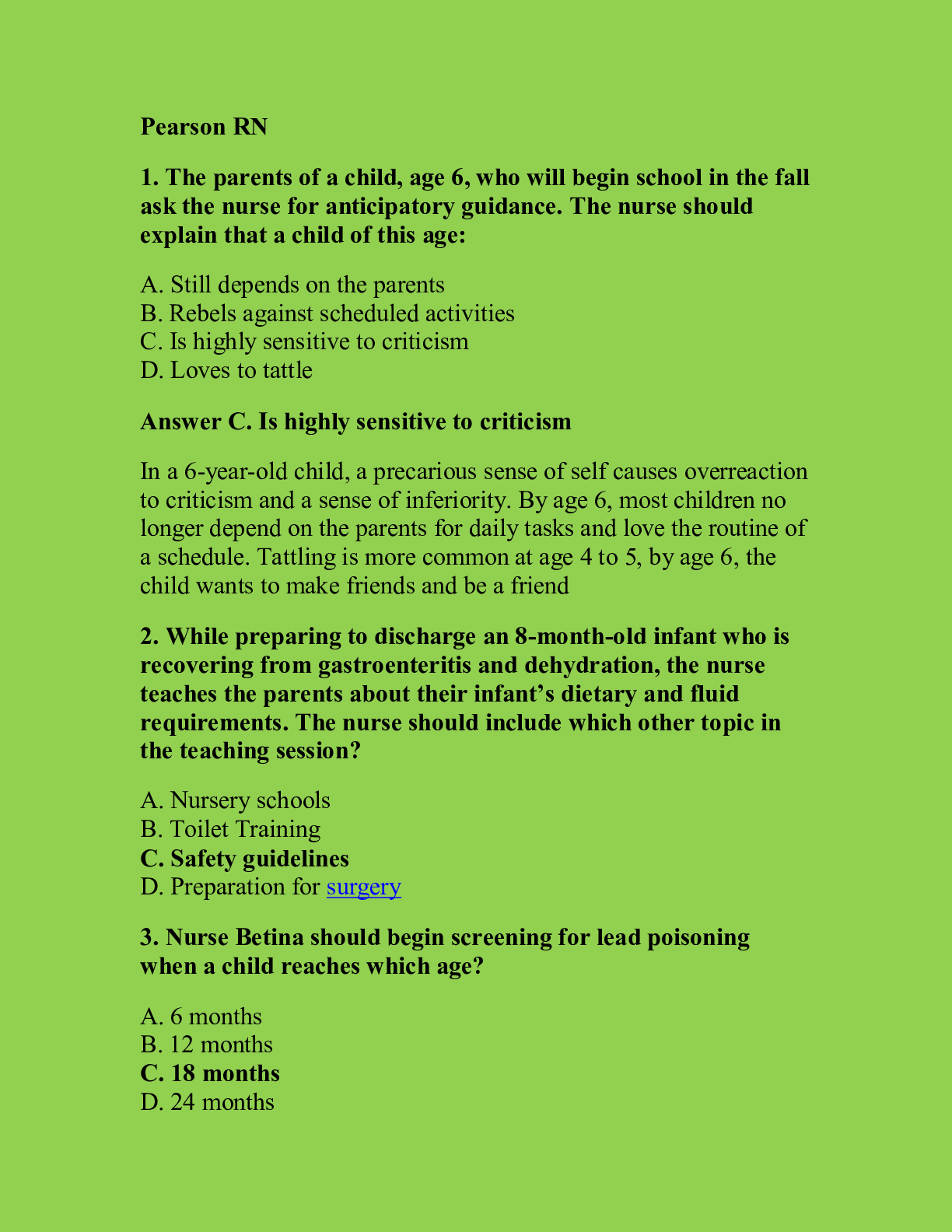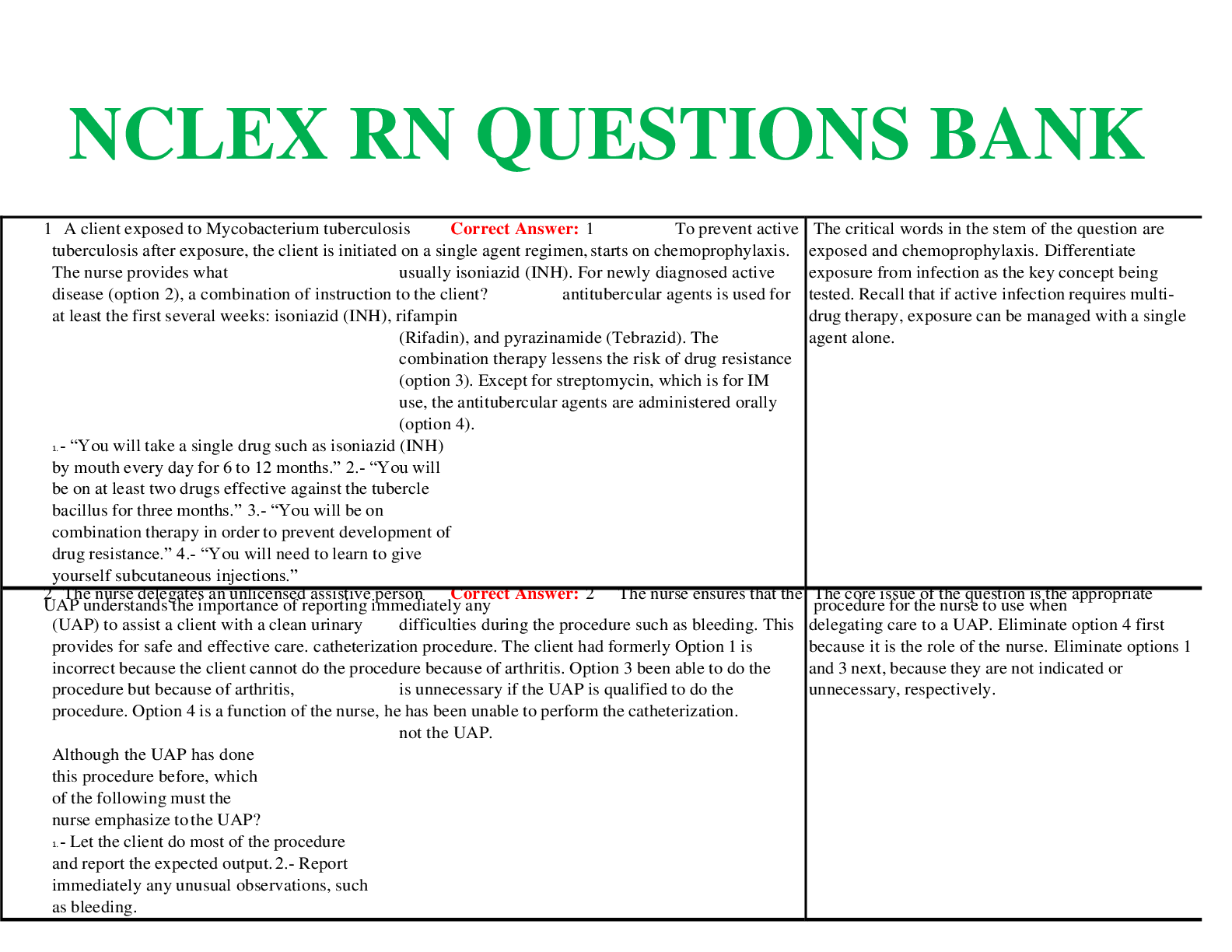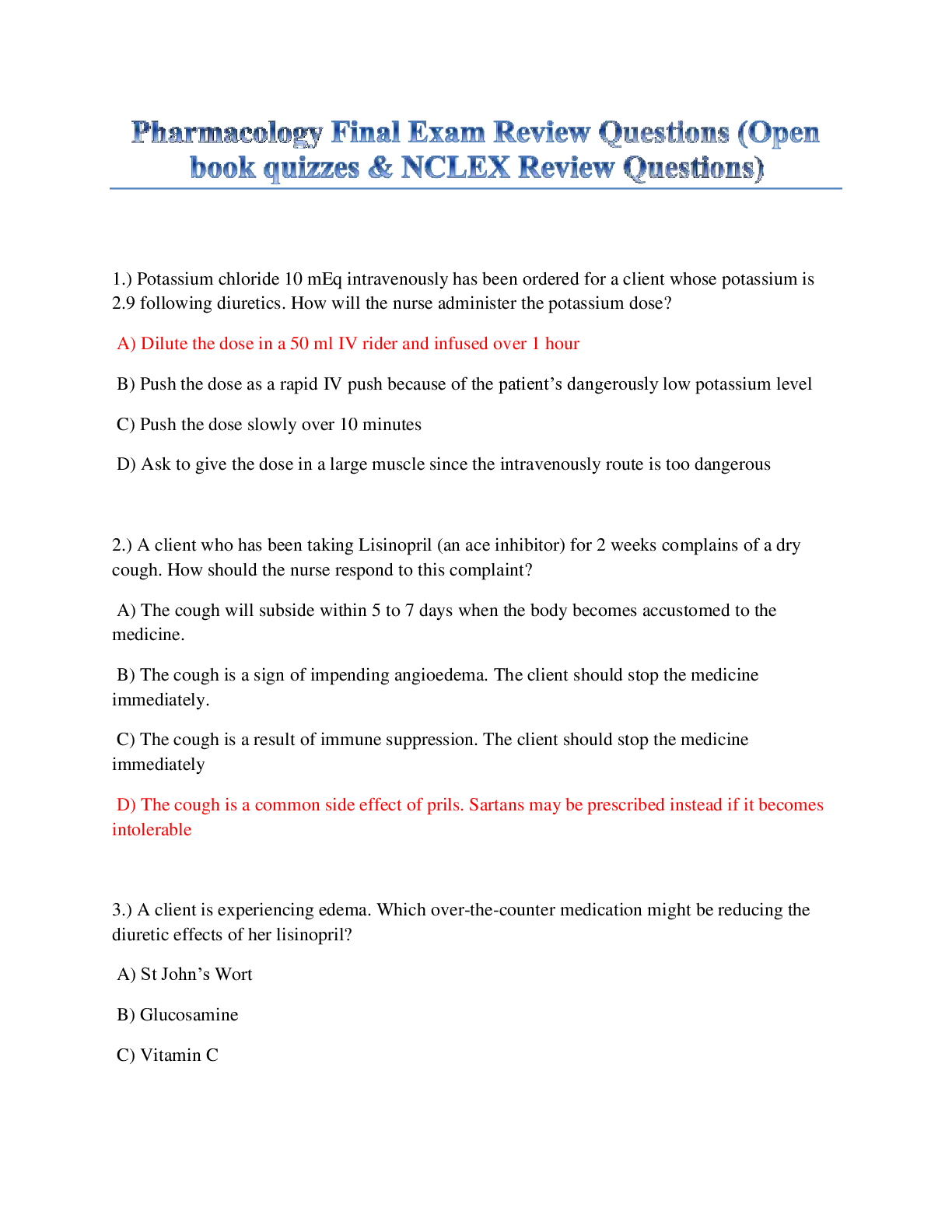NCSBN Pretest Question with accurate answers, Graded A+, 2022/2023 update.
Document Content and Description Below
Pretest Question 1 A c. What document should be in guiding the care of this client? A) Client Self Determination Act B) Physician's treatment orders C) Advance Directives. D) Clinical Pathway pr... otocols Review Information: The correct answer is: C) Advance Directives. This document specifies the client's wishes Question 2 You are the of a health care team that consists of one licensed practical/vocational nurse, one nursing assistant , a nursing student and yourself. To whom is it appropriate to assign complete care for A) Yourself B) The nursing student C) The licensed vocational nurse D) The nursing assistant Review Information: The correct answer is:A) Yourself. While the nurse may delegate a bed bath for a stable client, this care should be performed by an RN for a new admission. Only tasks that do not require independent judgment should be delegated. 3Question 3 A mother brings her the clinic, complaining that the child seems to be The nurse expects to find which of the following on the initial history and physical assessment? A) Increased temperature and lethargy B) Rash and restlessness C) Increased sleeping and listlessness D) Diarrhea and poor skin turgor Review Information: The correct answer is:B) Rash and restlessness.Question 4 As the nurse takes a history of a 3 year-old with neuroblastoma, what comments by the parents require follow-up and are consistent with the diagnosis? A) "The child has been listless and has lost weight." B) "Her urine is dark yellow and small in amounts." C) "Clothes are becoming tighter across her abdomen." D+) "We notice muscle weakness and some unsteadiness." Review Information: The correct answer is:C) "Clothes are becoming tighter across her abdomen.". One of the most common signs of neuroblastoma is increasing abdominal girth. The parents'' report that clothing is tight is significant, and should be followed by additional assessments. Question 5 A 16 year-old presents to the emergency department. The triage nurse finds that this teenager is legally married and signed the consent form for treatment. What would be the appropriate INITIAL action by the nurse? A) Refuse to see the client until a parent or legal guardian can be contacted B) Withhold treatment until telephone consent can be obtained from the spouse C) Refer the client to a community pediatric hospital emergency room D) Assess and treat in the same manner as any adult client Review Information: The correct answer is:D) Assess and treat in the same manner as any adult client. Minors may become known as an "emancipated minor" through marriage, pregnancy, high school graduation, independent living or service in the military. Therefore, this client, who is married, has the legal capacity of an adult. Question 6 A newly admitted elderly client is severely dehydrated. When planning care for this client, which one of the following is an appropriate task for an Unlicensed Assistive Personnel (UAP)?A) Obtain a history of fluid loss B) Report output of less than 30 ml/hr C) Monitor response to IV fluids D) Check skin turgor every four hours Review Information: The correct answer is:B) Report output of less than 30 ml/hr. When directing a UAP, the nurse must communicate clearly about each delegated task with specific instructions on what must be reported. Because the RN is responsible for all care-related decisions,only implementation tasks should be assigned because they do not require independent judgment. Question 7 The nurse is assessing a 4 year-old for possible rheumatic fever. Which of the following would the nurse suspect is related to this diagnosis? A) Diagnosis of chickenpox six months ago B) Exposure to strep throat in daycare last month C) Treatment for ear infection two months ago D) Episode of fungal skin infection last week Review Information: The correct answer is:B) Exposure to strep throat in daycare last month. Evidence supports a strong relationship between infection with Group A streptococci and subsequent rheumatic fever (usually within 2-6 weeks). Therefore, the history of playmates recovering from strep throat would indicate that the child diagnosed with rheumatic fever most likely also had strep throat. Sometimes, such an infection has no clinical symptoms. Question 8 When the nurse becomes aware of feeling reluctant to interact with a manipulative client, the BEST action by the nurse is to A) Discuss the feeling of reluctance with an objective peer or supervisor B) Limit contacts with the client to avoid reinforcing the manipulative behavior C) Confront the client regarding the negative effects of his/her behavior on others D) Develop a behavior modification plan that will promote more functional behavior Review Information: The correct answer is:A) Discuss the feeling of reluctance with an objective peer or supervisor. The nurse who is experiencing stress in the therapeutic relationship can gain objectivity through supervision. The nurse must attempt to discover attitudes and feelings in the self that influence the nurseclient relationship.Question 9 A client is being treated for paranoid schizophrenia. When the client became loud and boisterous, the nurse immediately placed him in seclusion as a precautionary measure. The client willingly complied. The nurse's action A) May result in charges of unlawful seclusion and restraint B) Leaves the nurse vulnerable for charges of assault and battery C) Was appropriate in view of the client's history of violence D) Was necessary to maintain the therapeutic milieu of the unit Review Information: The correct answer is:A) May result in charges of unlawful seclusion and restraint. Seclusion should only be used when there is an immediate threat of violence or threatening behavior. Question 10 A client has been admitted to the Coronary Care Unit with a Myocardial Infarction. Which of the following nursing diagnosis should have PRIORITY? A) Pain related to ischemia B) Risk for altered elimination: constipation C) Risk for complication: dysrhythmias D) Anxiety Review Information: The correct answer is:A) Pain related to ischemia. Pain is related to ischemia, and relief of pain will decrease myocardial oxygen demands, reduce blood pressure and heart rate and relieve anxiety. Pain also stimulates the sympathetic nervous system and increased preload, further increasing myocardial demands. Question 11 The nurse manager who is responsible for hiring professional nursing staff is required to comply with the Americans with Disabilities Act. The provisions of the law require the nurse manager to A) Maintain an environment free from hazards B) Provide reasonable accommodations for disabled individuals C) Make all necessary accommodations for disabled individualsD) Consider only physical disabilities in making employment decisions Review Information: The correct answer is:B) Provide reasonable accommodations for disabled individuals. The law is designed to permit persons with disabilities access to job opportunities. Employers must evaluate an applicant's ability to perform the job and not discriminate on the basis of a disability. Employers also must make "reasonable accommodations. Question 12 The mother of a school-aged child in a long leg cast asks the nurse how to relieve itching inside the cast. Which of the following is appropriate for the nurse to suggest as a remedy? A) Scratching the outside of the cast vigorously, applying pressure over the area B) Blowing a hair dryer or heat lamp on the cast over the area that is itching C) Using a long, smooth piece of wood to gently scratch the affected area D) Applying an ice pack over the area of the cast that is affected Review Information: The correct answer is:D) Applying an ice pack over the area of the cast that is affected. Applying ice is a safe method of relieving the itching. Question 13 Which of the following BEST describes the application of time management strategies in the role of the nurse manager? A) Scheduling staff efficiently to cover client needs B) Assuming a fair share of the client care as a role model C) Setting daily goals to prioritize work D) Delegating tasks to reduce work load Review Information: The correct answer is:C) Setting daily goals to prioritize work. Time management strategies must include setting priorities and meeting goals. Question 14 The clinic nurse assesses a toddler with a tentative diagnosis of neuroblastoma. Symptoms the nurse observes that suggest this problem include A) Lymphedema and nerve palsyB) Hearing loss and ataxia C) Headaches and vomiting D) Abdominal mass and weakness Review Information: The correct answer is:D) Abdominal mass and weakness. Clinical manifestations of neuroblastoma include an irregular abdominal mass that crosses the midline, weakness, pallor, anorexia, weight loss and irritability. Question 15 A fifteen year-old client has been placed in a Milwaukee Brace. Which one of the following statements from the client indicates the need for additional teaching? A) "I will only have to wear this for six months." B) "I should inspect my skin daily." C) "The brace will be worn day and night." D) "I can take it off when I shower." Review Information: The correct answer is:A) "I will only have to wear this for six months.". The brace must be worn long-term, usually for 1-2 years. Question 16 The nurse manager has been using a decentralized block scheduling plan to staff the nursing unit. However, staff have asked for many changes and exceptions to the schedule over the past few months. The manager considers self-scheduling knowing that A) Quality of care will improve B) Staff turnover should decrease C) Flexible scheduling will occur D) Team morale will improve Review Information: The correct answer is:D) Team morale will improve. Nurses are more satisfied with autonomy and control. The nurse manager becomes the facilitator of scheduling rather than the decision-maker of the schedule. Question 17 A client is admitted to the emergency room following an acute asthma attack. Which of the following assessments would be expected by the nurse? A) Diffuse expiratory wheezingB) Loose, productive cough C) No relief from inhalant D) Fever and chills Review Information: The correct answer is:A) Diffuse expiratory wheezing. In asthma, the airways are narrowed - creating difficulty getting air in and a wheezing sound. Question 18 The nurse manager hears a physician loudly criticizing one of the staff nurses in the hearing of others. The employee does not respond to the physician's complaints. The nurse manager's FIRST action should be A) Walk up to the physician and quietly ask that this unacceptable behavior stop B) Allow the staff nurse to handle this situation without interference C) Notify the Nursing Director and Medical Staff Chief of a breech of professional conduct D) Request an immediate private meeting with the physician and staff nurse Review Information: The correct answer is:D) Request an immediate private meeting with the physician and staff nurse. Assertive communication respects the needs of all parties to express themselves, but not at the expense of others. The nurse manager needs first to protect clients and other staff from this display and come to the assistance of the nurse employee. Question 19 A client voluntarily admits herself to the hospital due to suicidal ideation. The client has been on the unit for two days and is now demanding to be released. The MOST appropriate action is for the nurse to A) Tell the client that she cannot be released because she is still suicidal B) Inform the client that she can be released only if she signs a no suicide contract C) Discuss with the client the decision to leave and prepare for her discharge D) Instruct her regarding her right to sign out upon receipt of the physician's discharge order Review Information: The correct answer is:C) Discuss with the client the decision to leave and prepare for her discharge. Clients voluntarily admitted to the hospital have a right to demand and obtain release. Discussing the decision allows opportunity for other interventions. Question 20A client is admitted with infective endocarditis (IE). Which symptom would alert the nurse to a complication of this condition? A) Dyspnea B) Heart murmur C) Macular rash D) Hemorrhage Review Information: The correct answer is:B) Heart murmur. Large, soft, rapidly developing vegetations attach to the heart valves. They have a tendency to break off, causing emboli and leaving ulcerations on the valve leaflets. These emboli produce symptoms of cardiac murmur, fever, anorexia, malaise and neurologic sequelae of emboli. Furthermore, the vegetations may travel to various organs such as spleen, kidney, coronary artery, brain and lungs and obstruct blood flow. Question 21 A nurseadmits a premature infant who has respiratory distress syndrome. In planning care, nursing actions are based on the fact that the MOST likely cause of this problem stems from the infant's inability to A) Stabilize thermoregulation B) Maintain alveolar surface tension C) Begin normal pulmonary blood flow D) Regulate intracardiac pressure Review Information: The correct answer is:B) Maintain alveolar surface tension. Respiratory distress syndrome is primarily a disease related to developmental delay in lung maturation. Although many factors lead to the development of the problem, the central factor relates to the lack of a normally functioning surfactant system due to immaturity in lung development. Question 22 An 18 year-old client is admitted to intensive care from the emergency room following a diving accident. The injury is suspected to be at the level of the 2nd cervical vertebrae. The nurse's PRIORITY assessment should be A) Response to stimuli B) Bladder control C) Respiratory function D) Muscle weaknessReview Information: The correct answer is: C) Respiratory function. Spinal injury at the C-2 level results in quadriplegia. While the client will experience all of the problems identified, respiratory assessment is a priority. Question 23 The nurse is caring for a client who was successfully resuscitated from a pulseless dysrhythmia. Which of the following assessments is CRITICAL for the nurse to include in the plan of care? A) Hourly urine output B) White blood count C) Blood glucose every four hours D) Temperature every two hours Review Information: The correct answer is:A) Hourly urine output. Clients who have had an episode of decreased glomerular perfusion are at risk for pre-renal failure. This is caused by any abnormal decline in kidney perfusion that reduces glomerular perfusion. Pre-renal failure occurs when the effective arterial blood volume falls. Examples of this phenomena include a drop in circulating blood volume as in a cardiac arrest state or in low cardiac perfusion states such as congestive heart failure associated with a cardiomyopathy. Close observation of hourly urinary output is necessary for early detection of this condition. Question 24 The nurse admitting a 5 month-old who vomited nine times in the past six hours should observe for signs of A) Metabolic acidosis B) Metabolic alkalosis C) Respiratory acidosis D) Respiratory alkalosis Review Information: The correct answer is:B) Metabolic alkalosis. Vomiting causes loss of acid from the stomach. Prolonged vomiting can result in excess loss and lead to metabolic alkalosis. Question 25 A child is injured on the school playground and appears to have a fractured leg. The FIRST action the school nurse should take isA) Call for emergency transport to the hospital B) Immobilize the limb and joints above and below the injury C) Assess the child and the extent of the injury D) Apply cold compresses to the injured area Review Information: The correct answer is:C) Assess the child and the extent of the injury. When applying the nursing process, assessment is the first step in providing care. The 5 "Ps" of vascular impairment can be used as a guide (pain, pulse, pallor, paresthesia, paralysis). Question 26 As the nurse interviews the parents of a child with asthma, it is a PRIORITY to ask about A) Household pets B) New furniture C) Lead based paint D) Plants such as cactus Review Information: The correct answer is:A) Household pets. Animal dander is a very common allergen affecting persons with asthma. Other triggers may include pollens, carpeting and household dust. Question 27 An 80 year-old client was admitted with a diagnosis of possible cerebral vascular accident. Blood pressure has ranged from 180/110 to 160/100. Over the past several hours, the nurse noted increasing lethargy. Which of the following assessments should the nurse report IMMEDIATELY to the physician? A) Slurred speech B) Incontinence C) Muscle weakness D) Rapid pulse Review Information: The correct answer is:A) Slurred speech. Changes in speech patterns and level of conscious can be indicators of continued intercranial bleeding. Treatment options may change based on further diagnostic tests.Question 28 A 3 year-old child is brought to the clinic by his grandmother to be seen for "scratching his bottom and wetting the bed at night." Based on these complaints, the nurse would INITIALLY assess for A) Allergies B) Hyperactivity C) Regression D) Pinworms Review Information: The correct answer is:D) Pinworms. Signs of pinworm infection include intense perianal itching, poor sleep patterns, general irritability, restlessness, bed-wetting, distractibility and short attention span. Question 29 A 72 year-old client with osteomyelitis requires a six week course of intravenous antibiotics. In planning for home care, the MOST important action by the nurse is A) Investigating the client's insurance coverage for home IV antibiotic therapy B) Determining if there are adequate hand washing facilities in the home C) Assessing the client's ability to participate in self care and/or the reliability of a caregiver D) Selecting the appropriate venous access device Review Information: The correct answer is:C) Assessing the client''s ability to participate in self care and/or the reliability of a caregiver. The cognitive ability of the client as well as the availability and reliability of a caregiver must be assessed to determine if home care is a feasible option. Question 30 The mother of a child with a neural tube defect asks the nurse what she can do to decrease the chances of having another baby with a neural tube defect. The BEST response by the nurse is A) "Folic acid should be taken before and after conception." B) "Multivitamin supplements are recommended during pregnancy." C) "A well balanced diet promotes normal fetal development." D) "Increased dietary iron improves the health of mother and fetus." Review Information: The correct answer is:A) "Folic acid should be taken before and after conception.".The American Academy of Pediatrics recommends that all childbearing women increase folic acid from dietary sources and/or supplements. There is evidence that increased amounts of folic acid prevents neural tube defects. Question 31 The nurse is caring for a newborn with a neural tube defect. The BEST covering for the lesion is A) Telfa dressing with antibiotic ointment B) Moist sterile nonadherent dressing C) Dry sterile dressing D) Sterile occlusive pressure dressing Review Information: The correct answer is:B) Moist sterile nonadherent dressing. Before surgical closure the sac is prevented from drying by the application of a sterile, moist, nonadherent dressing over the defect. Dressings are changed frequently to keep them moist. Question 32 A nurse is providing a parenting class to individuals living in a community of older homes. In discussing formula preparation, which of the following is most important to prevent lead poisoning? A) Use ready-to-feed commercial infant formula B) Boil the tap water for 10 minutes prior to preparing the formula C) Let tap water run for 2 minutes before adding to concentrate D) Buy bottled water labeled "lead free" to mix the formula Review Information: The correct answer is:C) Let tap water run for 2 minutes before adding to concentrate. Use of lead-contaminated water to prepare formula is a major source of poisoning in infants. Drinking water may be contaminated by lead from old lead pipes or lead solder used insealing water pipes. Letting tap water run for several minutes will diminish the lead contamination. Question 33 A client is admitted to the rehabilitation unit following a CVA and mild dysphagia. The MOST appropriate intervention for this client is A) Position client in upright position while eating B) Place client on a clear liquid dietC) Tilt head back to facilitate swallowing reflex D) Offer finger foods such as crackers or pretzels Review Information: The correct answer is:A) Position client in upright position while eating. An upright position facilitates proper chewing and swallowing. Question 34 The nurse explains an autograft to a client scheduled for excision of a skin tumor. The nurse knows the client understands the procedure when the client says, "I will receive tissue from A) a tissue bank." B) a pig." C) my thigh." D) synthetic skin." Review Information: The correct answer is:C) my thigh.". Autografts are done with tissue transplanted from the client''s own skin. Question 35 The nurse is caring for a newborn with tracheoesophageal fistula. Which of the following nursing diagnoses is a PRIORITY? A) Risk for dehydration B) Ineffective airway clearance C) Altered nutrition D) Risk for injury Review Information: The correct answer is:B) Ineffective airway clearance. The most common form of TEF is one in which the proximal esophageal segment terminates in a blind pouch and the distal segment is connected to the trachea or primary bronchus by a short fistula at or near the bifurcation. Thus, a priority is maintaining an open airway, preventing aspiration. Other nursing diagnoses are then addressed. Question 36 A client has been hospitalized after an automobile accident. A full leg cast was applied in the emergency room. The MOST important reason for the nurse to elevate the casted leg is toA) Promote the client's comfort B) Reduce the drying time C) Decrease irritation to the skin D) Improve venous return Review Information: The correct answer is:D) Improve venous return. Elevating the leg both improves venous return and reduces swelling. Question 37 A nurse is working with family members of a newly diagnosed client with Alzheimer's disease. Which of the following interventions is MOST helpful? A) Teaching relaxation techniques B) Implementing a daily exercise routine C) Improving daily nutritional intake D) Suggesting communication strategies Review Information: The correct answer is:D) Suggesting communication strategies. Since Alzheimer''s disease is a progressive chronic illness that greatly challenges caregivers, the nurse can be of greatest assistance in helping family to identify language changes, and select verbal and nonverbal communication strategies to minimize aberrant behavior. Question 38 The nurse is teaching a client with non-insulin dependent diabetes mellitus about the prescribed diet. The nurse should teach the client to A) Maintain previous calorie intake B) Keep a candy bar available at all times C) Reduce carbohydrates intake to 25% of total calories D) Keep a regular schedule of meals and snacks Review Information: The correct answer is:D) Keep a regular schedule of meals and snacks. Currently, calorie-controlled diets with strict mealplans are rarely suggested for clients who have diabetes. Try to incorporate schedule or food changes into clients'' existing dietary patterns. Help clients learn to read labels and identify specific canned foods, frozen entrees, or other foods which are acceptable and those which should be avoided. Question 39The mother of a two month-old baby calls the nurse at a well-baby clinic two days after the first DTaP immunization. She reports that the baby feels very warm, has cried inconsolably for as long as three hours, and has had several shaking spells. The response of the nurse should be to A) instruct the mother to call 911 for an ambulance to transport the infant B) suggest that these are expected reactions and to begin every 4 hour antipyretics C) tell the mother to take the infant immediately to the nearest emergency room D) give instructions to bring the infant to the clinic now Review Information: The correct answer is:A)instruct the mother to call 911 for an ambulance to transport the infant The exhibited findings of the infant indicate a severe reaction to the immunizations. Immediate attention is needed & an ambulance with trained staff needs to transport because of the risk of grand mal seizures from potential encephalopathy which is a critical reaction. The mother would need to be instructed after this acute reaction to inform the provider of this reaction to the first dose of DTaP. Based on the need and risk involved to the infant, the health care provider may decide that further DTaP immunizations are contraindicated for life. The clinic nurse would need to document in the notes for this infant: the instructions given, findings reported by the mother and specific follow-up needs for the next clinic visit in relation to teaching and evaluation of the outcome of this event. Question 40 The nurse is teaching a class on HIV prevention. Which of the following should be emphasized as increasing risk? A) Donating blood B) Using public bathrooms C) Unprotected sex D) Touching a person with AIDS Review Information: The correct answer is:C) Unprotected sex. Because HIV is spread through exposure to bodily fluids, unprotected intercourse and shared drug paraphernalia remain the highest risk for infection. Question 41 A 6 year-old child is seen for the first time in the clinic. Upon assessment, the nurse finds that the child has short palpebral fissures, thinned upper lip, and hypoplastic philtrum of the upper lip. The mother states that the child seems to have problems in learning to count and recognizing basic colors. Based on this data, the nurse suspects that the child is MOST likely showing the effects of A) Congenital abnormalities B) Chronic toxoplasmosis C) Fetal alcohol syndrome D) Lead poisoningReview Information: The correct answer is:C) Fetal alcohol syndrome. Major features of fetal alcohol syndrome consist of facial and associated physical features, such as short palpebral fissure, hypoplastic philtrum, thinned upper lip, short, upturned nose. Behavioral problems, cognitive impairment and psychosocial deficits are also associated with this syndrome. Question 42 The nurse is performing the admission assessment of a client with an acute episode of asthma. Which of the following assessments would the nurse anticipate finding? A) Prolonged inspiration B) Expiratory wheezes C) Expectorating large amounts of purulent mucous D) Lethargy Review Information: The correct answer is:B) Expiratory wheezes. Asthma is characterized by expiratory wheezes caused by obstruction of the airways. Wheezes are a high pitched musical sounds produced by air moving through narrowed airways. Clients often associate wheezes with the feeling of tightness in the chest. Question 43 The nurse is planning a meal plan that would provide the most iron for a child with anemia. Which of the following dinner menus would be BEST? A) Fish sticks, french fries, banana, cookies, milk B) Ground beef patty, lima beans, wheat roll, raisins, milk C) Chicken nuggets, macaroni, peas, cantaloupe, milk D) Peanut butter and jelly sandwich, apple slices, milk Review Information: The correct answer is:B) Ground beef patty, lima beans, wheat roll, raisins, milk. Iron rich foods include red meat, fish, egg yolks, green leafy vegetables, legumes, whole grains, dried fruits such as raisins. This dinner is the best choice, high in iron and is appropriate for a toddler. Question 44 A ten year-old client is recovering from a splenectomy following a traumatic injury. The clients laboratory results show a hemoglobin of 9 g/dL and a hematocrit of 28 percent. The BEST approach for the nurse to use is toA) Limit milk and milk products B) Encourage bed activities and games C) Plan nursing care around lengthy rest periods D) Promote a diet rich in iron Review Information: The correct answer is:C) Plan nursing care around lengthy rest periods. The initial priority for this client is rest due to the inability of red blood cells to carry oxygen. Question 45 The nurse planning care for a 12 year-old child with sickle cell disease in a vaso-occlusive crisis of the elbow should include which one of the following as a PRIORITY? A) Limit fluids B) Client controlled analgesia C) Cold compresses to elbow D) Passive range of motion exercise Review Information: The correct answer is:B) Client controlled analgesia. Management of a crisis is directed towards supportive and symptomatic treatment. The priority of care is pain relief. In a 12 year-old child, client controlled analgesia promotes maximum comfort. Question 46 As the nurse provides discharge teaching to the parents of a 15 month-old child with Kawasaki Disease who has received immunoglobulin therapy, which one of the following instructions would be MOST appropriate? A) High doses of aspirin will be continued for some time B) Complete recovery is expected within several days C) Active range of motion exercises should be done frequently D) The measles, mumps and rubella vaccine should be delayed Review Information: The correct answer is:D) The measles, mumps and rubella vaccine should be delayed. Discharge instructions for a child with Kawasaki Disease should include immunoglobulin therapy may interfere with the body''s ability to form appropriate amounts of antibodies and live immunizations should be delayed.Question 47 The nurse is giving instructions to the parents of a child with Cystic Fibrosis. The nurse would emphasize that pancreatic enzymes should be taken A) Once each day B) Three times daily after meals C) With each meal or snack D) Each time carbohydrates are eaten Review Information: The correct answer is:C) With each meal or snack. Pancreatic enzymes should be taken with each meal and every snack to allow for digestion of all foods that are eaten. Question 48 The nurse is assessing an eight month-old infant with a malfunctioning ventriculoperitoneal shunt. Which one of the following manifestations would the infant be MOST likely to exhibit? A) Lethargy B) Irritability C) Negative Moro D) Depressed fontanel Review Information: The correct answer is:B) Irritability. Signs of IICP (increased intracranial pressure) in infants include bulging fontanel, instability, high-pitched cry, and cries when held. Vital sign changes include pulse that is variable, i.e., rapid, slow and bounding, or feeble. Respirations are more often slow, deep, and irregular. Question 49 The nurse is performing a physical assessment on a toddler. Which of the following should be the FIRST action? A) Perform traumatic procedures B) Use minimal physical contact C) Proceed from head to toe D) Explain the exam in detail Review Information: The correct answer is:B) Use minimal physical contact.The nurse should approach the toddler slowly and use minimal physical contact initially so as to gain the toddler''s cooperation. Be flexible in the sequence of the exam, and give only brief simple explanations just prior to the action. Question 50 A client has been tentatively diagnosed with Graves' disease (hyperthyroidism). Which of the following symptoms noted on the initial nursing assessment is expected? A) Recent weight gain B) Physical growth delay C) Protruding eyeballs D) Sudden onset of irritability Review Information: The correct answer is:C) Protruding eyeballs. Exophthalmos or protruding eyeballs is a distinctive characteristic of Graves'' Disease. Question 51 When assessing a client admitted to the hospital for diabetic acidosis, which of the following clinical manifestations would the nurse expect? A) A blood pH level above 7.5 B) Arterial blood PCO2 above 40 C) Blood pH level below 7.3 D) Arterial blood PCO2 below 10 Review Information: The correct answer is:C) Blood pH level below 7.3. In the absence of insulin, which facilitates the transport of glucose into the cell, the body breaks down fats and proteins to supply energy ketones, a by-product of fat metabolism. These accumulate causing metabolic acidosis (pH < 7.3). Question 52 The nurse is explaining the proper use of syrup of ipecac to a group of parents. For which of the following accidental poisonings is the treatment appropriate? A) Oven cleaner B) Drain cleaner C) Kerosene D) Chewable vitaminsReview Information: The correct answer is:D) Chewable vitamins. Of the above choices, poisoning with vitamins is the only case in which it is safe to induce vomiting with syrup of ipecac. Question 53 A two year-old child is brought to the pediatrician's office with a chief complaint of mild diarrhea for two days. Nutritional counseling by the nurse should include which one of the following statements? A) Place the child on clear liquids and gelatin for 24 hours B) Continue with the regular diet and include oral rehydration fluids C) Give bananas, apples, rice and toast as tolerated D) Place NPO for 24 hours, then rehydrate with milk and water Review Information: The correct answer is:B) Continue with the regular diet and include oral rehydration fluids. Current recommendations for mild to moderate diarrhea are to maintain a normal diet with rehydration fluids. Question 54 The nurse is teaching an elderly client how to use MDI's (multi-dose inhalers). The nurse is concerned that the client is unable to coordinate the release of the medication with the inhalation phase. The nurse's BEST recommendation for the client is A) Nebulized treatments for home care B) Adding a spacer device to the MDI canister C) Asking a family member to assist the client with the MDI D) Request a visiting nurse to follow the client at home Review Information: The correct answer is:B) Adding a spacer device to the MDI canister. The majority of pulmonary medications for COPD are delivered by inhalation.This is often preferred over oral administration because a lower drug dose is needed and systemic side effects are reduced. In addition, the onset of action of bronchodilator medication given via inhalation is faster. Question 55 Which of the following manifestations observed by the school nurse confirms the presence of pediculosis capitis in students? A) Scratching the head more than usualB) Flakes evident on a student's shoulders C) Oval pattern occipital hair loss D) Whitish oval specks sticking to the hair Review Information: The correct answer is:D) Whitish oval specks sticking to the hair. Diagnosis of pediculosis capitis is made by observation of the white eggs (nits) firmly attached to the hair shafts. Treatment includes shampoo application, such as lindane for children over 2 years of age, and meticulous combing and removal of all nits. Question 56 When parents call the emergency room to report that a toddler has swallowed drain cleaner, the nurse instructs them to call for emergency transport to the hospital. While waiting for an ambulance, the BEST action the nurse would suggest to the parents is A) Administer syrup of ipecac B) Offer small amounts of water C) Have the child drink milk D) Give ginger ale or cola Review Information: The correct answer is:B) Offer small amounts of water. Small amounts of water will dilute the corrosive substance prior to gastric lavage. Question 57 A client is scheduled for an IVP (Intravenous Pyelogram). Which of the following data from the client's history indicate a potential hazard for this test? A) Reflex incontinence B) Allergic to shellfish C) Claustrophobia D) Hypertension Review Information: The correct answer is:B) Allergic to shellfish. It is important to know if the client has an allergy to iodine or shellfish. If the client does, they may have an allergic reaction to the IVP contrast dye injected during the procedure. Question 58A high school nurse is advising a class of unwed pregnant students that the MOST important action they can perform to deliver a healthy child is A) Maintaining good nutrition B) Staying in school C) Keeping in contact with the child's father D) Getting adequate sleep Review Information: The correct answer is:A) Maintaining good nutrition. Nurses can serve a pivotal role in providing nutritional education and case management interventions. Weight gain during pregnancy is one of the strongest predictors of infant birth weight. Specifically, teens need to increase their intake of protein, vitamins, and minerals including iron. Pregnant teens who gain between 26 and 35 pounds have the lowest incidence of low-birth-weight babies. Question 59 The nurse is preparing a handout on infant feeding to be distributed to families visiting the clinic. Which of the following should be included in the teaching materials? A) Solid foods are introduced one at a time beginning with cereal B) Finely ground meat should be started early to provide iron C) Egg white is added early to increase protein intake D) Solid foods should be mixed with formula in a bottle Review Information: The correct answer is:A) Solid foods are introduced one at a time beginning with cereal. Solid foods should be added one at a time between 4-6 months. If the infant is able to tolerate the food, another may be added in a week. Iron fortified cereal is the recommended first food. Question 60 The nurse is caring for a client with sickle cell disease who is scheduled to receive a unit of packed red blood cells. Which of the following is an appropriate action for the nurse when administering the infusion? A) Storing the packed red cells in the medicine refrigerator while starting IV B) Slow the rate of infusion if the client develops fever or chills C) Limit the infusion time of each of the unit to a maximum of four hours D) Assess vital signs every 15 minutes throughout the entire infusion Review Information: The correct answer is:C) Limit the infusion time of each of the unit to a maximum of four hours.Infuse the specified amount of blood within 4 hours. If the infusion will exceed this time, the blood should be divided into appropriately sized quantities. Question 61 A client with a documented pulmonary embolism has the following arterial blood gases: PO2 - 70 mm hg, PCO2 - 32 mm hg, pH - 7.45, SaO2 - 87%, HCO3 - 22. Based on thisdata, what is the FIRST nursing action? A) Review other lab data B) Notify the physician C) Administer oxygen D) Calm the client Review Information: The correct answer is:C) Administer oxygen. The client has a low PCO2 due to increased respiratory rate from the hypoxemia and signs of respiratory alkalosis. Immediate intervention is indicated. Question 62 A client diagnosed with hepatitis C discusses his health history with the admitting nurse. The nurse should recognize which of the following as the MOST important data? A) Recent travel to Central America B) Ingestion of raw shellfish last week C) Multiple sex partners D) Blood transfusion 15 years ago Review Information: The correct answer is:D) Blood transfusion 15 years ago. The client who was transfused prior to blood screening for hepatitis C may show symptoms many years later. Question 63 A client is recovering from a thyroidectomy. While monitoring the client's initial post operative condition, which of the following should the nurse report immediately? A) Tetany and paresthesia B) Mild stridor and hoarsenessC) Irritability and insomnia D) Headache and nausea Review Information: The correct answer is: A) Tetany and paresthesia. Because the parathyroid gland may be damaged in this surgery, secondary hypocalcemia may occur. Symptoms of hypoparathyroidism include tetany, paresthesia, muscle cramps and seizures. Question 64 A client is admitted with a right upper lobe infiltrate, and also to rule out tuberculosis. The isolation precautions the nurse would institute include A) Positive pressure ventilation B) Gown and gloves C) Particulate respirator mask D) Barrier precautions Review Information: The correct answer is:C) Particulate respirator mask. Tight fitting, high-efficiency masks are required when caring for clients who have suspected communicable disease of the airborne variety. Question 65 A client had 20 mg of Lasix (furosemide) PO at 10 AM. Which would be essential for the nurse to include at the change of shift report? A) The client lost 2 pounds B) The client's potassium level is 4 mEq/liter. C) The client's urine output was 1500 cc in five hours D) The client is to receive another dose of Lasix at 10 PM Review Information: The correct answer is:C) The client's urine output was 1500 cc in five hours. Although all of these may be correct information to include in report, the essential piece would be the urine output. Question 66The nurse is caring for a client with a colostomy. During a teaching session, the nurse recommends that the pouch be emptied A) When it is one third to one half full B) Prior to meals C) After each fecal elimination D) At the same time each day Review Information: The correct answer is:A) When it is one third to one half full. If the pouch becomes more than half full it may separate from the flange. Question 67 A couple asks the nurse about risks of several birth control methods. The MOST appropriate response by the nurse would be A) Norplant is safe and may be removed easily B) Oral contraceptives should not be used by smokers C) Depo-Provera is convenient with few side effects D) The IUD gives protection from pregnancy and infection Review Information: The correct answer is:B) Oral contraceptives should not be used by smokers. The use of oral contraceptives in a pregnant woman who smokes increases her risk of cardiovascular problems. Question 68 Lactulose (Chronulac) has been prescribed for a client with advanced liver disease. Which of the following assessments would the nurse use to evaluate the effectiveness of this treatment? A) An increase in appetite B) A decrease in fluid retention C) A decrease in lethargy D) A reduction in jaundice Review Information: The correct answer is:C) A decrease in lethargy. Lactulose produces and acid environment in the bowel and trapsammonia in the gut; the laxative effect then aids in removing the ammonia from the body. This decreases the effects of hepatic encephalopathy, including lethargy and confusion.Question 69 The mother of a 3 month-old infant tells the nurse that she wants to change from formula towhole milk and add cereal and meats to the diet. What should be emphasized as the nurse teaches about infant nutrition? A) Solid foods should be introduced at 3-4 months B) Whole milk is difficult for a young infant to digest C) Fluoridated tap water should be used to dilute milk D) Supplemental apple juice can be used between feedings Review Information: The correct answer is:B) Whole milk is difficult for a young infant to digest. Cow''s milk is not given to infants younger than 1 year because the tough, hard curd is difficult to digest. Also it contains little iron and creates a high renal solute load. Question 70 The nurse is assessing a 55 year-old female client who is scheduled for abdominal surgery. Which of the following information would indicate that the client is at risk for thrombusformation in the post-operative period? A) Estrogen replacement therapy B) 10% less than ideal body weight C) Hypersensitivity to heparin D) History of hepatitis Review Information: The correct answer is:A) Estrogen replacement therapy. Estrogen increases the hypercoagualability of the blood and increased the risk for development of thrombophlebitis. Question 71 The nurse is planning discharge for a 90 year-old client with musculo-skeletal weakness. Which of the following interventions would be MOST effective in preventing falls? A) Place nightlights in bedroom B) Wear eyeglasses at all times C) Install grab bars in the bathroom D) Teach muscle strengthening exercisesReview Information: The correct answer is:A) Place nightlights in bedroom. Because more falls occur in the bedroom than any other location, begin there. However, work in partnership with the client and family so they are willing to move furniture, lamp cords, and storage areas; add lighting; remove throw rugs; and decrease other environmental hazards. Question 72 While obtaining the history of a two week-old infant during the well-baby exam, the nurse finds that the neonatal screening for phenylketonuria (PKU) was done when the infant was less than 24 hours-old. It is a PRIORITY for the nurse to A) Schedule the infant for a repeat test in two weeks B) Obtain a repeat blood test at this point C) Contact the hospital of birth for the results D) Document that the test results are pending Review Information: The correct answer is:B) Obtain a repeat blood test at this point. Testing for PKU is most reliable when protein has been ingested. A repeat blood specimen must be obtained by the third week of life if the initial specimen was taken from an infant less than 24 hours-old. Question 73 Two hours after the normal spontaneous vaginal delivery of a woman who is gravida 4 para 4, the nurse notes that the fundus is boggy and displaced slightly above and to the left of the umbilicus. The appropriate INITIAL nursing action is to A) Assess lochia for color and amount B) Monitor pulse and blood pressure C) Call the physician immediately D) Ask the woman to empty her bladder Review Information: The correct answer is:D) Ask the woman to empty her bladder. A full bladder can displace the uterus and prevent contraction. After the woman empties the bladder, the fundus should be assessed again. Question 74 An 8 year-old client is admitted to the hospital for surgery. The child's parent reports several allergies. Which of the following should all health care personnel be aware of?A) Shellfish B) Molds C) Balloons D) Perfumed soap Review Information: The correct answer is:C) Balloons. Allergy to balloons indicates a latex allergy. All personnel in contact with the child will need to be aware of this condition and use non-latex gloves. Question 75 The nurse is caring for a client who is post-op following a thoracotomy. The client has two chest tubes in place,connected to one chest drain. The nursing assessment reveals bubbling in the water seal chamber when the client coughs. What is the MOST appropriate nursing action? A) Clamp the chest tube B) Call the surgeon immediately C) Continue to monitor the client to see if the bubbling increases D) Instruct the client to try to avoid coughing Review Information: The correct answer is:C) Continue to monitor the client to see if the bubbling increases. Bubbling associated with coughing after lung surgery is to be expected as small amounts of air escape the pleural space when pressures inside the chest increase with coughing. Monitoring is the only nursing action required. Question 76 The nurse is reinforcing teaching to a 24 year-old woman receiving acyclovir (Zovirax) for a Herpes Simplex Virus type 2 infection. The nurse should instruct the client to A) Complete the entire course of the medication for an effective cure B) Begin treatment with acyclovir at the onset of symptoms of recurrence C) Stop treatment if she thinks she may be pregnant to prevent birth defects D) Continue to take prophylactic doses for at least five years after the diagnosis Review Information: The correct answer is:B) Begin treatment with acyclovir at the onset of symptoms of recurrence.When the client is aware of early symptoms, such as pain, itching or tingling, treatment is very effective. Question 77 An eight year-old child is hospitalized during the edema phase of minimal change nephrotic syndrome. The nurse is assisting in choosing the lunch menu. Which one of the following is the BEST choice? A) Bologna sandwich, pudding, milk B) Frankfurter, baked potato, milk C) Chicken strips, corn on the cob, milk D) Grilled cheese sandwich, apple, milk Review Information: The correct answer is:C) Chicken strips, corn on the cob, milk. This menu is lowest in sodium. Ideally, low fat milk would be available. Question 78 The nurse is teaching parents about accidental poisoning in children. Which of the following should be emphasized? A) Start treatment before calling the Poison Control Center B) Empty the child's mouth in any case of possible poisoning C) Do not move the child if a toxic substance was inhaled D) Induce vomiting if the poison is a hydrocarbon Review Information: The correct answer is:B) Empty the child''s mouth in any case of possible poisoning. Emptying the mouth of poison interferes with further ingestion and should be done first to limit contact with the substance. Question 79 Which of the following symptoms contraindicate the use of haloperidol (Haldol) and warrant withholding the dose? A) Drowsiness, lethargy, and inactivity B) Dry mouth, nasal congestion, and blurred vision C) Rash, blood dyscrasias, severe depression D) Hyperglycemia, weight gain, and edemaReview Information: The correct answer is:C) Rash, blood dyscrasias, severe depression. Rash and blood dyscrasias are side effects of anti-psychotic drugs. A history of severe depression is a contraindication to the use of neuroleptics. Question 80 The nurse is planning care for a 14 year-old client returning from scoliosis corrective surgery. Which of the following actions should receive PRIORITY in the plan? A) Antibiotic therapy for 10 days B) Teach client isometric exercises for legs C) Assess movement and sensation of extremities D) Assist to stand up at bedside within the first 24 hours Review Information: The correct answer is:C) Assess movement and sensation of extremities. Following corrective surgery for scoliosis, neurological status requires special attention and assessment, especially that of the extremities. Question 81 A three year-old child diagnosed as having celiac disease attends a day care center. Which of the following would be an appropriate snack? A) Cheese crackers B) Peanut butter sandwich C) Potato chips D) Vanilla cookies Review Information: The correct answer is:C) Potato chips. Children with celiac disease should eat a gluten free diet. Gluten is found mainly in grains of wheat and rye and in smaller quantities in barley and oats. Corn, rice, soybeans and potatoes are digestible in persons with celiac disease. Question 82 The nurse is caring for a 14 month-old just diagnosed with Cystic Fibrosis. The parents state this is the first child in either family with this disease, and ask about the risk to future children. The BEST response by the nurse is based on the knowledge that there is a A) 1 in 4 chance for each child to carry that trait B) 1 in 4 risk for each child to have the disease C) 1 in 2 chance of avoiding the trait and diseaseD) 1 in 2 chance that each child will have the disease Review Information: The correct answer is:B) 1 in 4 risk for each child to have the disease. Cystic Fibrosis is an autosomal recessive transmission pattern. In this situation, both parents must be carriers of the trait for the disease since neither one of them has the disease. Therefore, for each pregnancy, there is a 25% chance of the child having the disease, 50% chance of carrying the trait and a 25% chance of having neither the trait or the disease. Question 83 A client with moderate persistent asthma is admitted for a minor surgical procedure. On admission the peak flow meter is measured at 480 liters/minute. Post-operatively the client is complaining of chest tightness. The peak flow has dropped to 200 liters/minute. What should the nurse do FIRST? A) Notify the physician B) Administer the prn dose of Albuterol C) Apply oxygen at 2 liters per nasal cannula D) Repeat the peak flow reading in 30 minutes Review Information: The correct answer is: B) Administer the prn dose of Albuterol. Peak flow monitoring during exacerbations of asthma is recommended for clients with moderate-to-severe persistent asthma to determine the severity of the exacerbation and to guide the treatment. A peak flow reading of less than 50% of the client''s baseline reading is a medical alert condition and a short-acting beta-agonist must be taken immediately. Question 84 What nursing observation signifies that a client has attained the stage of concrete operations (Piaget)? A) Explores his environment using sight and movement B) Can think in mental images or word pictures C) Makes the moral judgment that "stealing is wrong" D) Reasons that homework is time-consuming but necessary Review Information: The correct answer is:C) Makes the moral judgment that "stealing is wrong". The stage of concrete operations is depicted by logical thinking and moral judgments. Question 85The nurse is caring for a 17 month-old with acetaminophen poisoning. Which of the following lab reports should the nurse review FIRST? A) Protime (PT) and partial thromboplastin time (PTT) B) Red blood cell and white blood cell counts C) Blood urea nitrogen and creatinine clearance D) Liver enzymes (AST and ALT) Review Information: The correct answer is:D) Liver enzymes (AST and ALT). Because acetaminophen is toxic to the liver and causes hepatic cellular necrosis, liver enzymes are released into the blood stream and serum levels of those enzymes rise. Other lab values are reviewed as well. Question 86 The nurse is teaching parents about diet for a 4 month-old infant with gastroenteritis and mild dehydration. In addition to oral rehydration fluids, the diet should include A) Formula or breast milk B) Broth and tea C) Rice cereal and apple juice D) Gelatin and ginger ale Review Information: The correct answer is:A) Formula or breast milk. The usual diet for a young infant should be followed. Question 87 The nurse instructs the client taking dexamethasone (Decadron) to take it with food or milk because this medication A) Retards pepsin production B) Stimulates hydrochloric acid production C) Slows stomach emptying time D) Decreases production of hydrochloric acid Review Information: The correct answer is:B) Stimulates hydrochloric acid production. Decadron increases the production of hydrochloric acid, which may cause gastrointestinal ulcers.Question 88 The nurse is planning care for a 3 month-old infant immediately postoperative following placement of a ventriculoperitoneal shunt for hydrocephalus. The nurse needs to A) Assess for abdominal distention B) Maintain infant in an upright position C) Begin formula feedings when infant is alert D) Pump the shunt to assess for proper function Review Information: The correct answer is:A) Assess for abdominal distention. The child is observed for abdominal distention because cerebrospinal fluid may cause peritonitis or a postoperative ileus as a complication of distal catheter placement. Question 89 The mother of a two year-old hospitalized child asksthe nurse's advice about the child's screaming every time the mother gets ready to leave the hospital room. The BEST response of the nurse would be to A) Request the mother to remain with the child at all times B) Explain that this behavior will stop with in a few days C) Help the mother understand this is a normal response to hospitalization D) Suggest that the mother "sneak out" of the child's room when he sleep Review Information: The correct answer is:C) Help the mother understand this is a normal response to hospitalization. The protest phase of separation anxiety is a normal response for a child this age. Question 90 When caring for a client receiving warfarin sodium (Coumadin), the nurse would monitor the results of the client's A) Bleeding time B) Coagulation time C) Prothrombin time D) Partial thromboplastin time Review Information: The correct answer is:C) Prothrombin time.Coumadin is ordered daily, based on the client''s prothrombin time (PT). This test evaluates the adequacy of the extrinsicsystem and common pathway in the clotting cascade; Coumadin affects the Vitamin K dependent clotting factors. Question 91 The nurse is caring for a four year-old two hours after tonsillectomy and adenoidectomy. Which of the following assessments must be reported IMMEDIATELY? A) Vomiting of dark emesis B) Complaints of throat pain C) Apical heart rate of 110 D) Increased restlessness Review Information: The correct answer is:D) Increased restlessness. Restlessness and increased respiratory and heart rates are often early signs of hemorrhage. care of infants and children. Question 92 The nurse admits a 7 year-old to the emergency room following a leg injury. X-rays show that there is a femur fracture near the epiphysis. The nurse should be aware that at this age, the injury MOST likely will A) Heal quickly because of thin periosteum B) Result in retarded bone growth C) Stimulate bone growth in the affected leg D) Show more rapid union than that of a younger child Review Information: The correct answer is: B) Result in retarded bone growth. An epiphyseal (growth) plate fracture in a 7 year-old often results in retarded bone growth. Limbs will be different in length. Question 93 A client receiving chlorpromazine HCL (Thorazine) is in psychiatric home care. During a home visit the nurse observes the client smacking her lips alternately with grinding her teeth. The nurse assesses this as A) DystoniaB) Akathesia C) Brady dysknesia D) Tardive dyskinesia Review Information: The correct answer is:D) Tardive dyskinesia. Signs of tardive dyskinesia include smacking lips, grinding of teeth and "fly catching" tongue movements. Question 94 While the nurse assesses a 2 month-old infant, the mother expresses concern because a flat pink birthmark on the baby's forehead and eyelid has not gone away. The nurse should tell the parents that A) Mongolian spots are a normal finding in dark-skinned children B) Port wine stains are often associated with other malformations C) Telangiectatic nevi are normal and will disappear as the baby grows D) The child is too young for surgical removal at this time Review Information: The correct answer is:C) Telangiectatic nevi are normal and will disappear as the baby grows. Telangiectatic nevi, salmon patch or stork bite birthmarks are a normal variation and the facial nevi will generally disappear by ages 1-2 years. Question 95 A client has returned to the unit following a renal biopsy. Which of the following nursing interventions is appropriate? A) Ambulate the client 4 hours after procedure B) Maintain client on NPO status for 24 hours C) Monitor vital signs D) Change dressing every eight hours Review Information: The correct answer is:C) Monitor vital signs. The potential complication of this procedure is internal hemorrhage. Monitoring vital signs is critical to detect early indications of bleeding. Question 96The nurse assessing a newborn notices that the breasts are enlarged bilaterally with a white, thin discharge. The INITIAL action of the nurse should be to A) Notify the attending practitioner B) Ask about medications taken in pregnancy C) Record the findings as "normal" D) Obtain fluid to send for culture Review Information: The correct answer is:C) Record the findings as "normal". Newborn infants of both sexes may have engorged breasts and may secrete milk during the first few days and weeks following birth. Question 97 A client has been admitted with a fractured femur and has been placed in skeletal traction. Which of the following nursing interventions should receive PRIORITY? A) Maintaining proper body alignment B) Frequent neurovascular assessments of the affected leg C) Inspection of pin sites for evidence of drainage or inflammation D) Applying an over-bed trapeze to assist the client with movement in bed Review Information: The correct answer is:B) Frequent neurovascular assessments of the affected leg. The most important activity for the nurse is to assess neurovascular status. Compartment syndrome is a serious complication of fractures. Prompt recognition of this neurovascular problem and early intervention may prevent permanent limb damage. Question 98 The nurse is teaching a client newly diagnosed with asthma how to use the metered-dose inhaler (MDI). The client asks when they will know the canister is empty. The BEST response is A) Drop the canister in water to observe floating B) Estimate how many doses are usually in the canister C) Count the number of doses as the inhaler is used D) Shake the canister to detect any fluid movement Review Information: The correct answer is:A) Drop the canister in water to observe floating.Dropping the canister into a bowl of water assesses the amount of medications remaining in a metereddose inhaler. The client should obtain a refill when the inhaler rises to the surface and begins to tip over. Question 99 While teaching the family of a child who will take phenytoin (Dilantin) regularly for seizure control, it is MOST important for the nurse to teach them to A) Maintain good oral hygiene and dental care B) Omit medication if the child is seizure free C) Administer acetaminophen to promote sleep D) Serve a diet that is high in iron Review Information: The correct answer is:A) Maintain good oral hygiene and dental care. Swollen and tender gums occur often with use of phenytoin. Oral hygiene and regular visits to the dentist should be emphasized. Question 100 A two year-old child has just been diagnosed with Cystic Fibrosis. The child's father asks the nurse "What are the chances that another child of ours will have Cystic Fibrosis?" Which of the following is the BEST response? A) "The probability of recurrence is unknown." B) "Cystic Fibrosis is more common in Asians." C) "Each of your children have a 25% chance of having Cystic Fibrosis." D) "The incidence of Cystic Fibrosis is approximately 1: 14,000 live births." Review Information: The correct answer is:C) "Each of your children have a 25% chance of having Cystic Fibrosis.". Cystic Fibrosis is an autosomal recessive disease. There is a 25% chance of each pregnancy of these parents resulting in a child with Cystic Fibrosis. Question 101 A 7 month pregnant woman is admitted with complaints of painless vaginal bleeding over several hours. The nurse should prepare the client for an immediate A) Non stress testB) Abdominal ultrasound C) Pelvic exam D) X-ray of abdomen Review Information: The correct answer is:B) Abdominal ultrasound. The standard for diagnosis of placenta previa, which is suggested in the client''s history, is abdominal ultrasound. Question 102 The nurse is assessing a 17 year-old female client with bulimia. Which of the following laboratory reports would the nurse anticipate? A) Increased serum glucose B) Decreased albumin C) Decreased potassium D) Increased sodium retention Review Information: The correct answer is:C) Decreased potassium. In bulimia, loss of electrolytes can occur in addition to signs and symptoms of starvation and dehydration. Question 103 An 80 year-old client on digitalis (Lanoxin) reports nausea, vomiting, abdominal cramps and halo vision. Which of the following laboratory results should the nurse analyze FIRST? A) Potassium levels B) Blood pH C) Magnesium levels D) Blood urea nitrogen Review Information: The correct answer is:A) Potassium levels. The most common cause of digitalis toxicity is a low potassium level. Clients must be taught that it is important to have adequate potassium intake while taking diuretics. Question 104A mother telephones the clinic and tells the nurse she is concerned because her breastfed 1 month-old has soft, yellow stoolsafter each feeding. The nurse's BEST response would be based on the knowledge that A) This type of stool is normal for breast fed infants B) The stool should have turned to light brown by now C) Formula supplements will add bulk to the stools D) Water should be offered several times each day Review Information: The correct answer is:A) This type of stool is normal for breast fed infants. In breast-fed infants, stools are frequent and yellow to golden and vary from soft to thick liquid in consistency. No change in feedings is indicated. Question 105 The nurse caring for a 9 year-old child with a fractured femur is told that a medication error occurred. The child received twice the ordered dose of morphine an hour ago. Which of the following nursing diagnoses is a PRIORITY at this time? A) Risk for fluid volume deficit related to morphine overdose B) Decreased gastrointestinal mobility related to mucosal irritation C) Ineffective breathing patterns related to central nervous system depression D) Altered nutrition related to inability to control nausea and vomiting Review Information: The correct answer is:C) Ineffective breathing patterns related to central nervous system depression. Respiratory depression is a life-threatening risk in this overdose. Question 106 A pregnant client asks the nurse about the scheduled blood test for alpha-fetoprotein (AFP). The nurse's BEST explanation i A) "It tells us how far along your pregnancy is." B) "The results help determine if the baby is growing normally." C) "Placental exchange of oxygen is measured." D) "Possible neurological defects may be identified." Review Information: The correct answer is:D) "Possible neurological defects may be identified.".A fetus with neural tube defects loses alfa-fetoprotein (AFP) to the amniotic fluid and hence the maternal blood. High levels indicate the possibility of defects such as spina bifida and meningocele. Further assessments are indicated if a test is positive. Question 107 The nurse notes that a 2 year-old child recovering from a tonsillectomy has an temperature of 98.2 degrees F at 8:00 AM. At 10:00 AMthe child's mother reports that the child "feels very warm" to touch. The FIRST action by the nurse should be to A) Reassure the mother that this is normal B) Offer the child cold oral fluids C) Reassess the child's temperature D) Administer the prescribed acetaminophen Review Information: The correct answer is:C) Reassess the child''s temperature. A child''s temperature may have rapid fluctuations. The nurse should listen to and show respect for what parents say. Question 108 The nurse is assessing an eight month-old child. The nurse would anticipate that the child would be able to A) Say two words B) Pull up to stand C) Sit without support D) Use a spoon Review Information: The correct answer is:C) Sit without support. The age at which the normal child develops the ability to sit steadily without support is 8 months. Question 109 The nurse is teaching a newly diagnosed asthma client on how to use a peak flow meter. The nurse explains that this should be used to A) Determine oxygen saturationB) Measure forced expiratory volume C) Monitor atmosphere for presence of allergens D) Provide metered doses for inhaled bronchodilator Review Information: The correct answer is:B) Measure forced expiratory volume. The peak flow meter is used to measure peak expiratory flow volume. It provides useful information about the presence and/or severity of airway obstruction. Question 110 The nurse is performing a pre-kindergarten physical on a five year-old. The last series of vaccines will be administered. What is the preferred site for injection by the nurse? A) Vastus intermedius B) Gluteus rainlinus C) Vastus lateralis D) DorsogluteaI Review Information: The correct answer is:C) Vastus lateralis. Vastus lateralis, a large and well developed muscle, is the preferred site, since it is removed from major nerves and blood vessels. Question 111 A client experienced the loss of a seven month fetus. The nurse planning for discharge should emphasize A) Discussing feelings with support persons B) Focusing on the other healthy children C) Seeking causes for the fetal death D) Planning another pregnancy very soon Review Information: The correct answer is:A) Discussing feelings with support persons. In communicating therapeutically, the nurse helps the couple begin the grief process by suggesting they seek family, friends and support groups to listen to their feelings. Question 112 The parents of a 4 year-old hospitalized child tell the nurse they will leave for a time and return at 6 PM. When the child asks when the parents will come again, the nurse can BEST respond by sayingA) "They will be back right after supper." B) "In about 2 hours, you will see them." C) "After you play awhile, they will be here." D) "When the clock hands are on 6 and 12." Review Information: The correct answer is:A) "They will be back right after supper." Time is not completely understood by a 4 year-old. The child interprets time with his own frame of reference. Thus it is best to explain time in relationship to an event. Question 113 The nurse is providing instructions for a client with asthma. Which of the following should the client monitor on a daily basis? A) Respiratory rate B) Peak air flow volumes C) Pulse oximetry D) Skin color Review Information: The correct answer is:B) Peak air flow volumes. The peak airflow volume decreases about 24 hours before clinical manifestations. Question 114 Therapeutic nurse-client interaction occurs when the nurse A) Assists the client to clarify the meaning of what the client is communicating B) Interprets the client's covert communication C) Praises the client for appropriate behavior D) Advises the client on ways to resolve problems Review Information: The correct answer is:A) Assists the client to clarify the meaning of what the client is communicating. Clarification is a facilitating/therapeutic communication strategy. Approval, changing the focus/subject, and advising are non-therapeutic/barriers to communication. Question 115 A 14 month-old child ingested half a bottle of aspirin tablets. Which of the following would the nurse expect to see in the child?A) Hypothermia B) Edema C) Dyspnea D) Epistaxis Review Information: The correct answer is:D) Epistaxis. A large dose of aspirin inhibits prothrombin formation and lowers platelet levels. With an overdose, clotting time is prolonged. Question 116 The nurse is caring for a client with a distal tibia fracture. The client has had a closed reduction and application of a toe to groin cast. Thirty-six hours after surgery, the client suddenly becomes confused, short of breath and spikes a temperature of 103 degrees F. The FIRST assessment the nurse should perform is A) Orientation to time, place and person B) Pulse oximetry C) Circulation to casted extremity D) Blood pressure Review Information: The correct answer is:B) Pulse oximetry. Restlessness, confusion, irritability and disorientation may be the first signs of fat embolism syndrome followed by a very high temperature. The nurse needs to confirm hypoxia first. Question 117 Which nursing intervention will be MOST effective in helping a withdrawn client to develop relationship skills? A) Offer the client frequent opportunities to interact with you B) Remind the client frequently to interact with other clients C) Assist the client to analyze the meaning of her behavior D) Identify for her other clients who have similar problems Review Information: The correct answer is:A) Offer the client frequent opportunities to interact with you. The withdrawn client is uncomfortable in social interaction. The nurse client relationship is a corrective relationship in which the client learns both tolerance and skills for relationships. Question 118The nurse is assessing a client with a stage 2 skin ulcer. Which of the following treatments is most effective to promote healing? A) Covering the wound with a dry dressing B) Using hydrogen peroxide soaks C) Leaving the area open to dry D) Applying a transparent film cover Review Information: The correct answer is:D) Applying a transparent film cover. For this type of ulcer, the most effective treatment is a transparent cover. Question 119 A female client is admitted for a breast biopsy. She says, tearfully to the nurse, "If this turns out to be cancer and I have to have my breast removed, my husband will never come near me." The nurse's BEST response would be A) "You are underestimating your husband's ability to love you." B) "Are you concerned that your husband will reject you?" C) "Are you wondering about the effect on your sexual relations?" D) "Are you worried that the surgery will change you?" Review Information: The correct answer is:D) "Are you worried that the surgery will change you?" This is a response that encourages further discussion without focusing on an area that the nurse, but possibly not the client, feels is a problem. Question 120 When teaching suicide prevention to the parents of a 15 year-old who recently attempted suicide, the nurse describes the following behavioral cue A) Angry outbursts at significant others B) Fears of being left alone C) Giving away valued personal items D) Experiencing the loss of a boyfriend Review Information: The correct answer is:C) Giving away valued personal items. 80% of all potential suicide victims give some type of clue. These clues might lead one to suspect that a client is holding suicidal thoughts or is developing a plan.Question 121 The nurse is caring for a 4 year-old admitted after receiving burns to more than 50% of his body. Which laboratory data should be reviewed by the nurse as a PRIORITY in the first 24 hours? A) Blood urea nitrogen B) Hematocrit C) Blood glucose D) White blood count Review Information: The correct answer is:A) Blood urea nitrogen. Glomerular filtration is decreased in the initial response to severe burns, with fluid shift. Kidney function must be monitored closely, or renal failure may follow in a few days. Question 122 The nurse is caring for a client in a Coronary Care Unit two days following a Myocardial Infarction. The client has many questions about his condition. The nurse should focus teaching about A) Immediate needs and concerns B) Post discharge rehabilitation C) Medication therapy at home D) Activity and rest schedule Review Information: The correct answer is:A) Immediate needs and concerns. Client education of the post MI client should be limited to immediate needs and concerns. Question 123 The nurse is preparing a client with a deep vein thrombosis (DVT) for a Venous Doppler evaluation. Which of the following would be necessary for preparing the client for this test? A) Client should be NPO after midnight B) Client should receive a sedative medication prior to the test C) Discontinue anti-coagulant therapy prior to the test D) No special preparation is necessary Review Information: The correct answer is:D) No special preparation is necessary.This is a non-invasive procedure and does not require preparation. Question 124 While interviewing a client, the nurse notices that the client is shifting positions, wringing her hands, and avoiding eye contact. It is important for the nurse to A) Ask the client what she is feeling B) Assess the client for auditory hallucinations C) Recognize the behavior as a side effect of medication D) Re-focus the discussion on a less anxiety provoking topic Review Information: The correct answer is:A) Ask the client what she is feeling. The initial step in anxiety intervention is observing, identifying, and assessing anxiety. Question 125 Parents of a 4 year-old boy have just been informed that their son has a congenital neurologic demyelinating disorder that is terminal. The nurse evaluates their reaction as which phase of the crisis process? A) Pre-crisis phase B) Impact phase C) Crisis phase D) Resolution phase Review Information: The correct answer is:B) Impact phase. The impact of crisis is indicative of high levels of stress, sense of helplessness, confusion, disorganization, and the inability to apply problem solving behavior. Question 126 A postpartum mother is unwilling to allow the father to participate in the newborn's care, although he is interested in doing so. She states, "I am afraid the baby will be confused about who the mother is. Baby raising is for mothers, not fathers." The nurse's BEST initial intervention is to A) Discuss with the mother sharing parenting responsibilities B) Help the mother to express her feelings and concerns C) Arrange for the parents to attend infant care classesD) Talk with the father and help him accept the wife's decision Review Information: The correct answer is:B) Help the mother to express her feelings and concerns. Non-judgmental support for expressed feelings may lead to resolution of competitive feelings in a new family. Cultural influences may also be revealed. Question 127 Which of the following statements made by a female client indicate to the nurse that she may have a thought disorder? A) "I'm so angry about this. Wait until my husband hears about this." B) "I'm a little confused. What time is it?" C) "I can't find my 'mesmer' shoes. Have you seen them?" D) "I'm fine. It's my daughter who has the problem." Review Information: The correct answer is:C) "I can''t find my ''mesmer'' shoes. Have you seen them?". A Neologism is a new word self invented by a person and not readily understood by another that is often associated with a thought disorder. Question 128 The nurse is aware that which of the following psychosocial needs are BEST described in the adolescent when hospitalized? [Show More]
Last updated: 1 year ago
Preview 1 out of 499 pages
Instant download

Instant download
Also available in bundle (1)
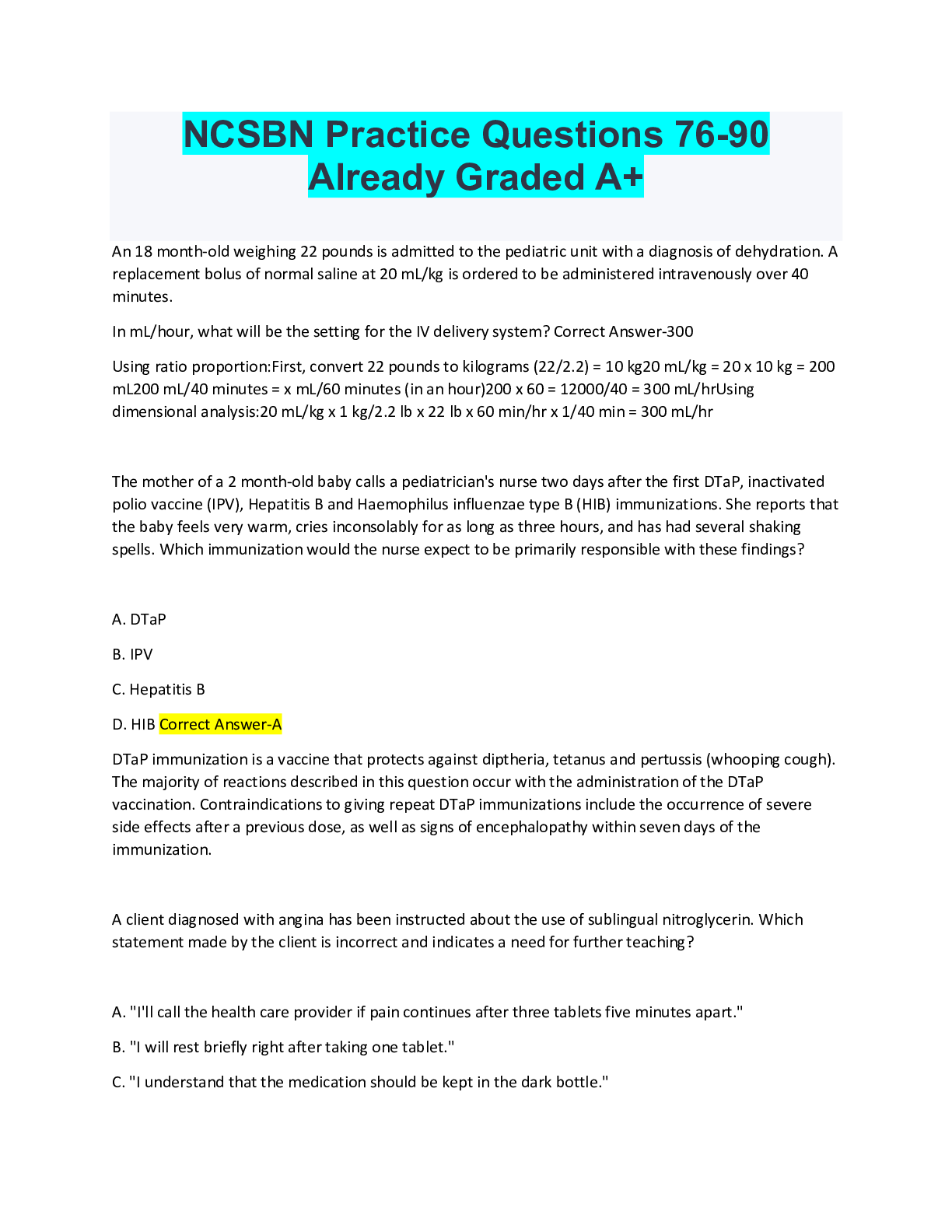
NCSBN EXAM REVISON BUNDLE, QUESTIONS WITH ACCURATE ANSWERS, GRADED A+, LATEST UPDATES
COMPRISES OF ALL QUESTIONS AND ANSWERS DOCUMENTS, ALL YOU NEED TO PASS THE NCSBN EXAMS
By bundleHub Solution guider 1 year ago
$38
17
Reviews( 0 )
Document information
Connected school, study & course
About the document
Uploaded On
Aug 30, 2022
Number of pages
499
Written in
Additional information
This document has been written for:
Uploaded
Aug 30, 2022
Downloads
0
Views
102

